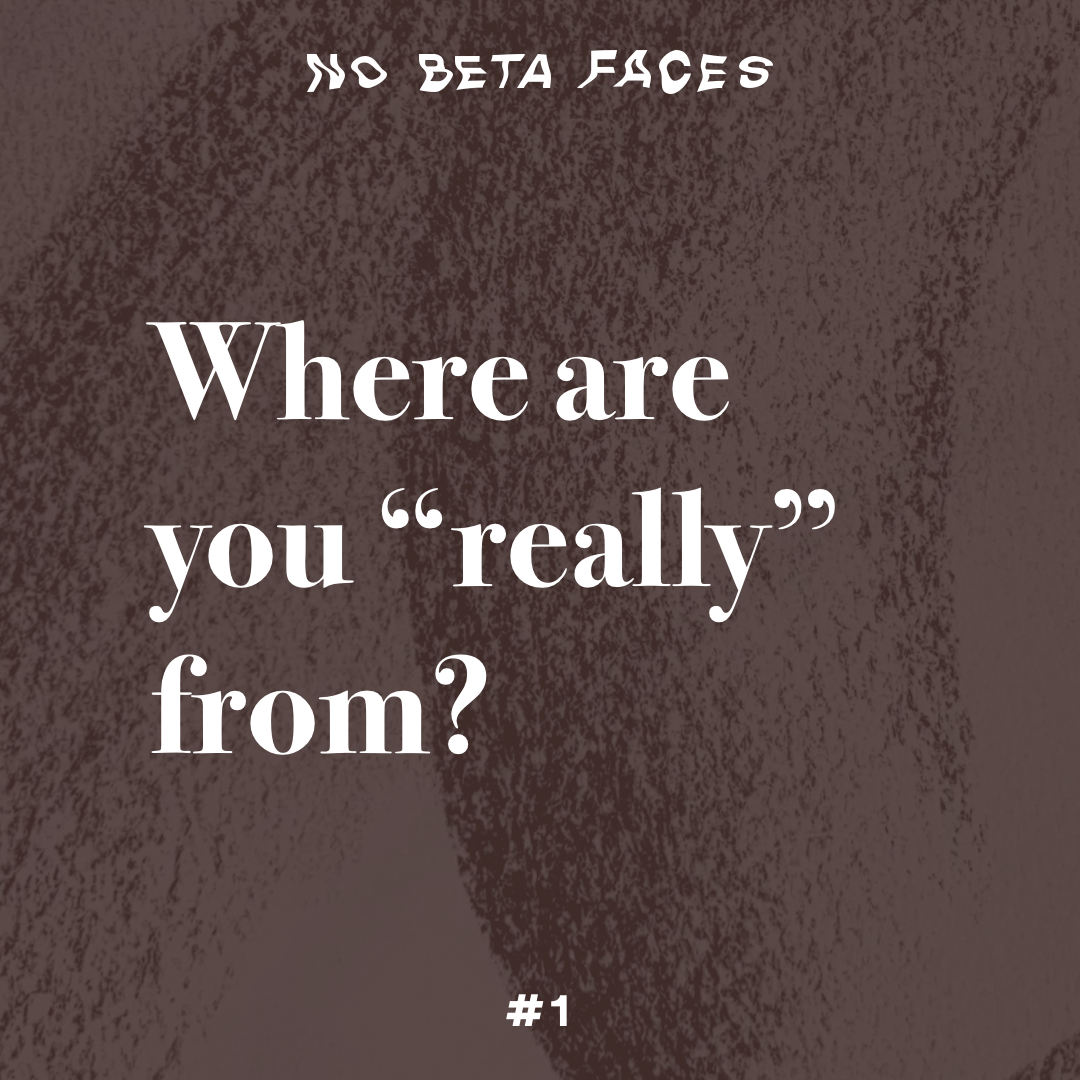
Have you ever asked someone where they are from just because the color of their skin? Have you followed up with: “Yes, you’re from here, but your parents, where did they come from?” These microagressions feel like mosquito bites for those concerned — seemingly small at first, but over time they start collecting and becoming deeply uncomfortable.

Dr. Phillip Atiba Goff works with US police departments to help public safety be more equitable and less deadly. He develops what he calls a “data driven vaccine against racial disparities in policing”, showing us how technology and data can be used for promoting positive change.
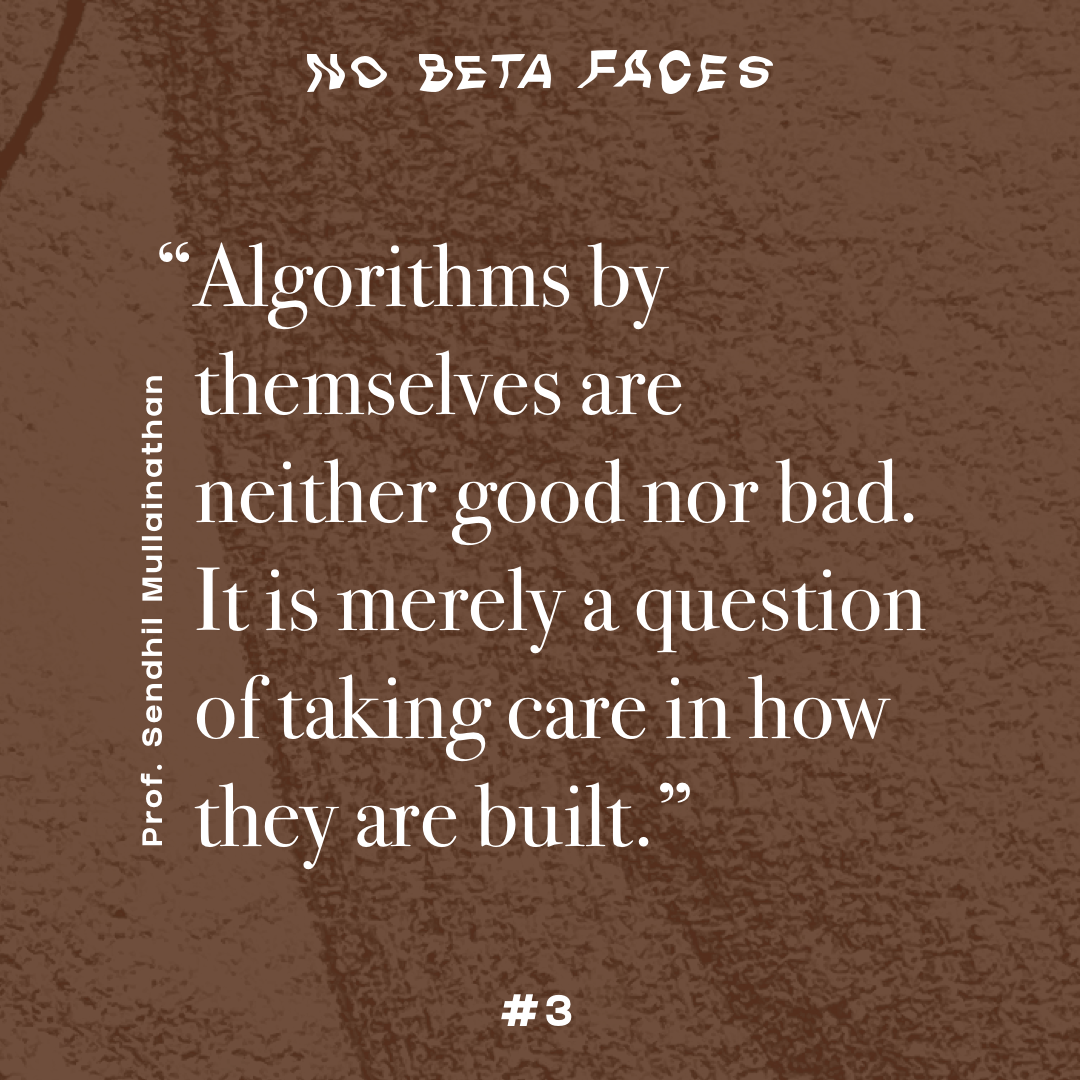
IBM announced a couple of weeks ago it will stop developing or selling facial recognition software due to concerns the technology is used to promote racism. Amazon followed suit and bans the use of its facial recognition AI for law enforcement for the next year. Error rates for facial recognition systems from major tech companies for identifying darker-skinned individuals were dozens of percentage points higher than when identifying lighter-skinned individuals. To some extent the issues lie in the data sets used to train the systems, which can be overwhelmingly male and white. Despite the advances in AI, biases remain along the lines of race, ethnicity, age and gender.
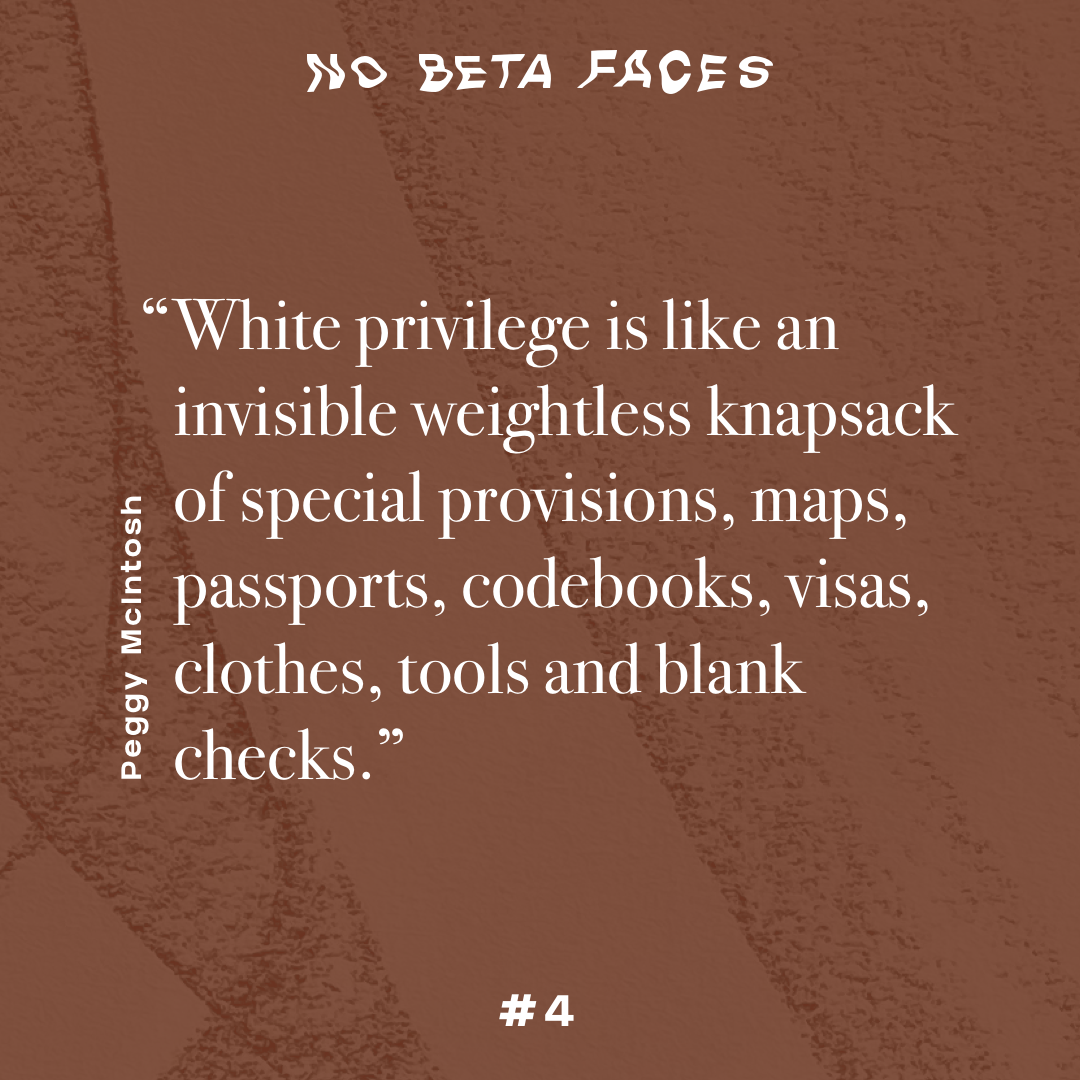
Some examples of what white people have in their knapsack of white privilege quoted from this research by Peggy McIntosh:
- I can turn on the television or open to the front page of the paper and see people of my race widely represented.
- I can be pretty sure that my children’s teachers and employers will tolerate them if they fit school and workplace norms […].
- I can talk with my mouth full and not have people put this down to my color.
- I am never asked to speak for all the people of my racial group.
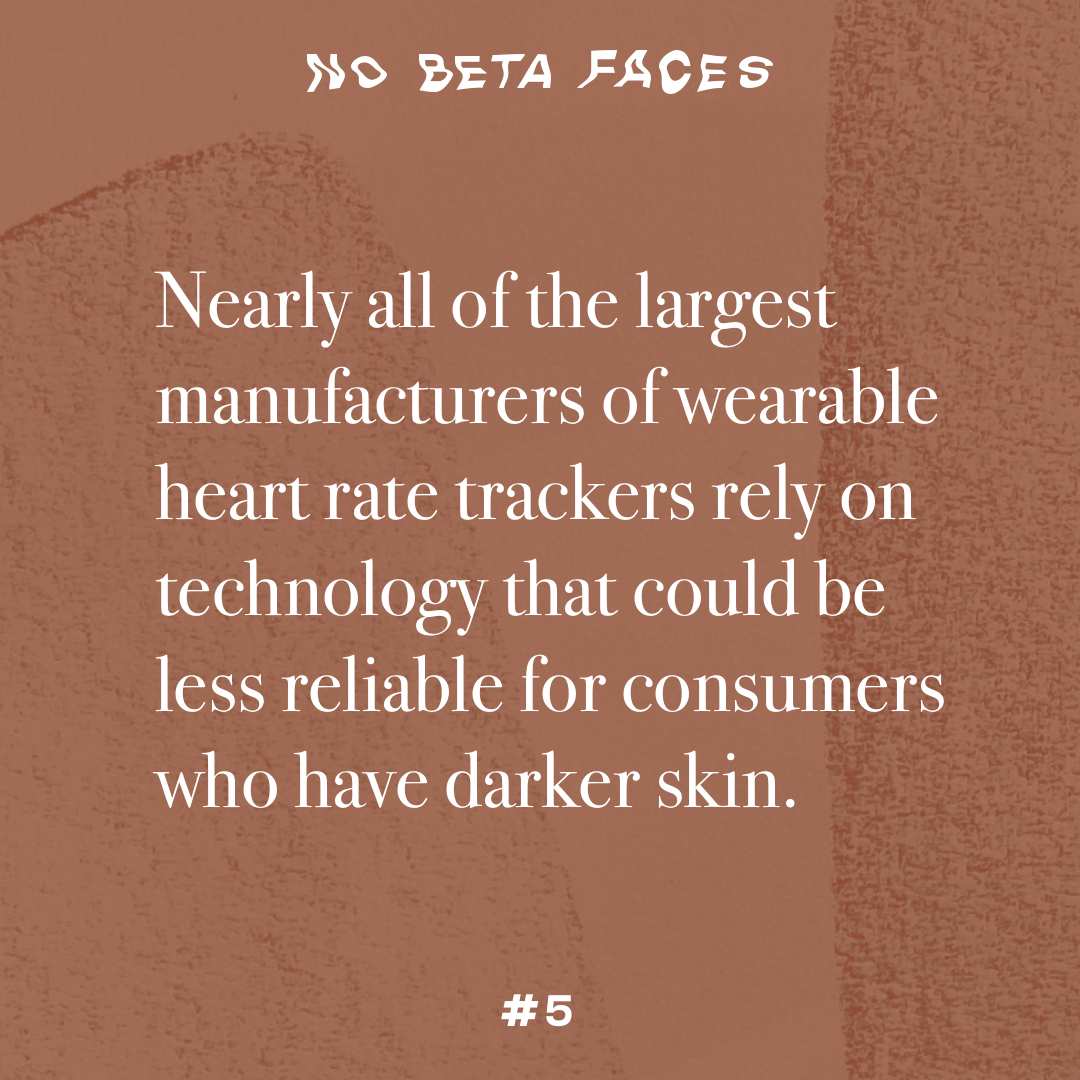
Wearable heart trackers, including those from Fitbit, Garmin, and Samsung, rely on optical sensors that monitor blood volume. But skin with more melanin blocks green light, making it more difficult to get an accurate reading, and making it less reliable for consumers with darker skin.
“It goes to a bit of a deeper issue, when you start talking about who’s in the room when these devices are being tested, who’s in the room when these devices are being designed, and … are the companies taking the time to make sure that the entire population is represented when they’re developing this technology.” — Vernon Ross

From the 17th to the 19th century, ships carrying weapons sailed from Europe to Africa to exchange them there for slaves. People in Africa were enslaved and shipped to America to be sold there. In America, these slaves produced products e.g. coffee, sugar or cotton, which was then shipped back to Europe. Even though no slaves were transported directly to Europe, Europe was actively involved in the transatlantic triangular trade.
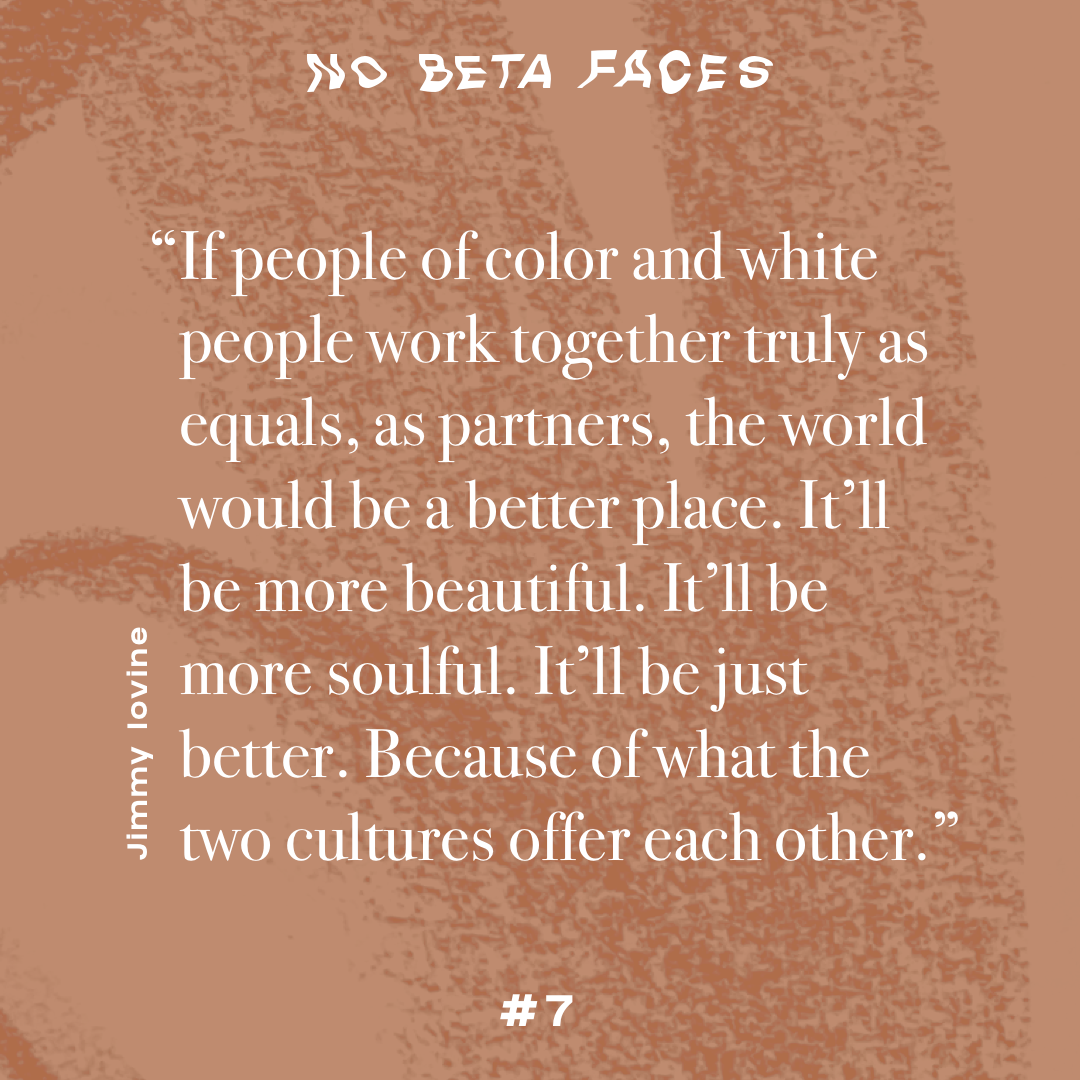
Taken from a conversation between Jimmy Iovine and Dr Dre, the two music moguls whose partnership eventually led to building Beats Electronics and Beats by Dre which was sold to Apple for $ 3 billion.

May the voices we include in our creation process be as diverse and inclusive as the users we create for — only then will we truly be sure to represent and develop meaningful human-centric experiences for all. Read the whole interview from Invision with Chan Williams to learn why representation is so important in creating good experiences.
![Diversify your feed. “You will certainly find yourself challenged. […] Question your assumptions. Get out of your comfort zone. You’ll be smarter for it, and learn crucial lessons in empathy. Sometimes it’s the little things.” (James Govenor) Diversify your feed. “You will certainly find yourself challenged. […] Question your assumptions. Get out of your comfort zone. You’ll be smarter for it, and learn crucial lessons in empathy. Sometimes it’s the little things.” (James Govenor)](media/posts/no_beta_faces_09.png)
One way to start acknowledging and learning from marginalized groups is to confront yourself with their view on the world. This does apply to all groups, from ethnicity to gender, from body types to users with a different social status. Learn from their voices, from their views and experiences by diversifying your feeds. It can start small by adding someone new on Twitter or Instagram. Tools like Proporti.onl and #Diversifyyourfeed support you in checking how (gender) diverse your Twitter feed is and are fun to play with. Let’s work on our empathy for different perspectives and experiences of life.
![Happyland, noun [ˈhæpilænd] Metaphor for the state of consciousness white people are in before they have actively confronted racism as a system and their own racist socialization. (Tupoka Ogette) Happyland, noun [ˈhæpilænd] Metaphor for the state of consciousness white people are in before they have actively confronted racism as a system and their own racist socialization. (Tupoka Ogette)](media/posts/no_beta_faces_10.png)
Happyland is home to convinced non-racists who live in the agreement that only bad people are racist. Even the accusation of being racist weighs worse in Happyland than the effects of being racist itself. Racism is a societal, social construct which is interwoven into all structures and areas of our society. We must actively shape the system in which we live. It’s long overdue to leave Happyland.
- Audio book “EXIT RACISM” by Tupoka Ogette (Spotify / german)
- Website for the book “EXIT RACISM” with further materials (german)

The discourse around decolonizing design makes us question how we arrive at our acquired design taste which we employ in our daily work. “The work designers make is inspired by taste, and taste is often derived from what we’re exposed to during our upbringing. But design values and history is taught through a canon; that accepted pantheon of work by predominantly European and American male designers that sets the basis for what is deemed “good” or “bad”. The authority of the canon has undermined the work produced by non-Western cultures and those from poorer backgrounds.”
- Example 1: While styles and fashion from Western background are dubbed as design, Ghanaian textiles are classified as craft which attributes a certain inferiority to history and design practices from other cultures.
- Example 2: In the much celebrated Bauhaus movement, the few participating women were cast aside to weaving activities with their ideas in other fields being disregarded.
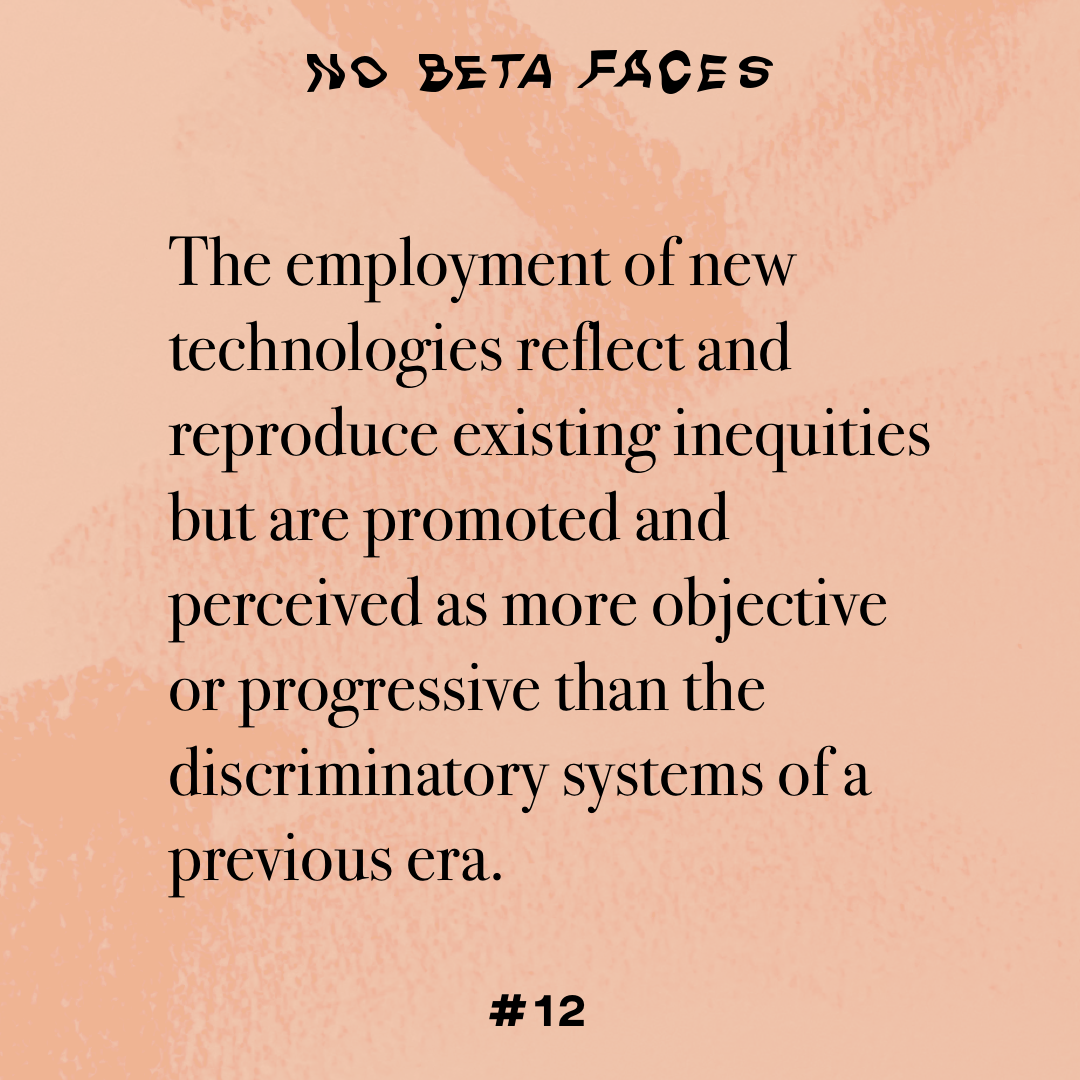
Human-centric design without considering issues of race and ethnicity fails an entire group of humanity.

Racism starts at our own doorstep. Coming back to the topic of microaggressions from one of our first posting, this “mosquito bite” happened in the Hamburg Verkehrsamt Mitte. The protagonist wanted to renew her driver’s license, but wasn’t recognized and captured by the automated photo machine. After several tries of even recognizing her face, the photos were automatically rejected and flagged as “conspicuous”.
- Read about her story here (Zeit+ subscription needed / german)


The port of Hamburg connected the colonies with the German Empire. Colonial goods such as palm oil, ivory, coffee, cinnamon, cocoa, bananas and tea were stored in the newly built Speicherstadt since 1888 and sold from there. Hamburg was often the last stop for colonial officials, missionaries, merchants and settlers who went to the colonies. At the same time Hamburg was the first station for people from the colonies.
Hamburg’s claim to be the gateway to the (colonial) world was underlined by the establishment of its own Ethnological Museum in 1879 (today called MARKK) and in 1908 by the founding of the Colonial Institute, from which the Hamburg University emerged. Like the Völkerschauen in the Hagenbeck Zoo, these institutions were closely linked to colonial ideology and culture.
- What’s the future for the colonial monuments in Hamburg? (YouTube / german)
- Hamburg’s history (Geschichtsbuch Hamburg / german)

Alexis Ohanian, founder and former CEO of reddit, decided to resign as his way of protesting racial injustice. The move can be viewed from different standpoints: on the one hand it is a strong message. On the other hand one might ask whether it will really contribute to change or rather is a clever self-marketing move? Recently we saw a different kind of change in our very own organization: Accenture Ventures announced the Black Founders Development Program to “elevate black founders in technology”. It will be interesting to see how our industry will make a collective effort for positive change in the coming years.

The words we use can quickly lose their original meaning and become wrapped in layers of connotation. It’s important to consider this and not use coded-language to avoid addressing the exact issue at hand. Words like “community” and “diversity” have, unfortunately, become words to use to hide our discomfort with race — but not addressing race is not enough, in fact, it often only continues racism. Learn more about coded-language here.
How to actively avoid using coded-language: Consider the words you are using when discussing programs or race-related topics. Are you using unspecific words? Be mindful and leave no room for misinterpretations. Never underestimate the power your words hold — in everyday conversations or even presentations. Words are where change begins.
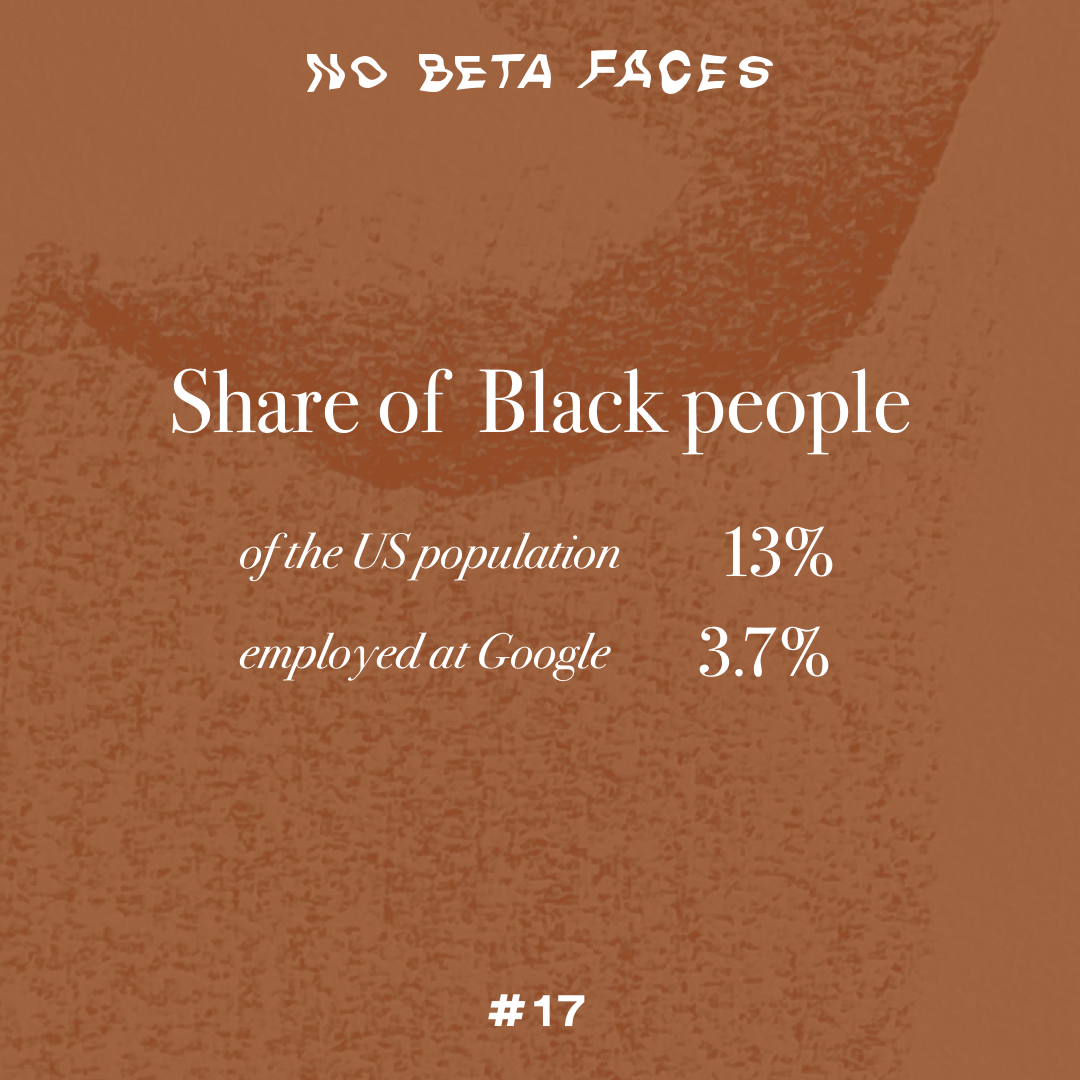
While Black people represent 13 % of the total U.S. population, recent diversity reports from Facebook, Google, and Apple indicate that only 3.8%, 3.7%, and 9% (go Apple) of their employees identify as Black. An even smaller proportion fill technical or leadership roles. Amazon's diversity report boasts over 26% Black representation. This is both true and misleading, because only a small fraction of that 26% gets to build or manage Amazon's technology. (Most of the Black people Amazon employs work in fulfillment centers.)
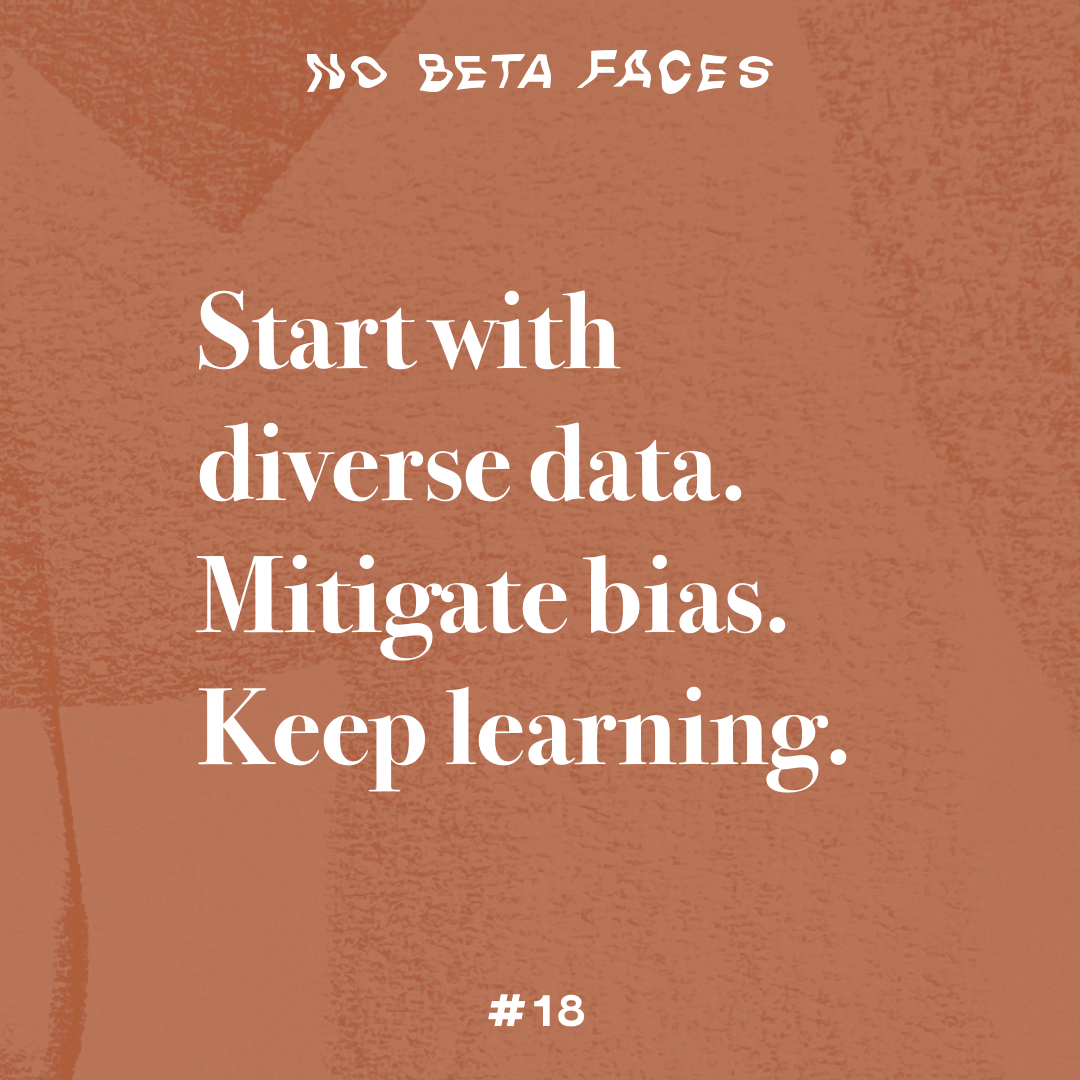
As Pinterest is a highly visual tool, the company sought out to make their search more inclusive in the last years. Based on its mission statement to “bring everyone the inspiration to create a life they love” the focus shifted to everyone in this project. This article gives insight into how Pinterest made their search more inclusive and, yes, more user-centric through that. “These new skin tone ranges are paving the way for more inclusive inspirations to be recommended in search”. It’s inspiring to get access to the teams’ approach and line of action.
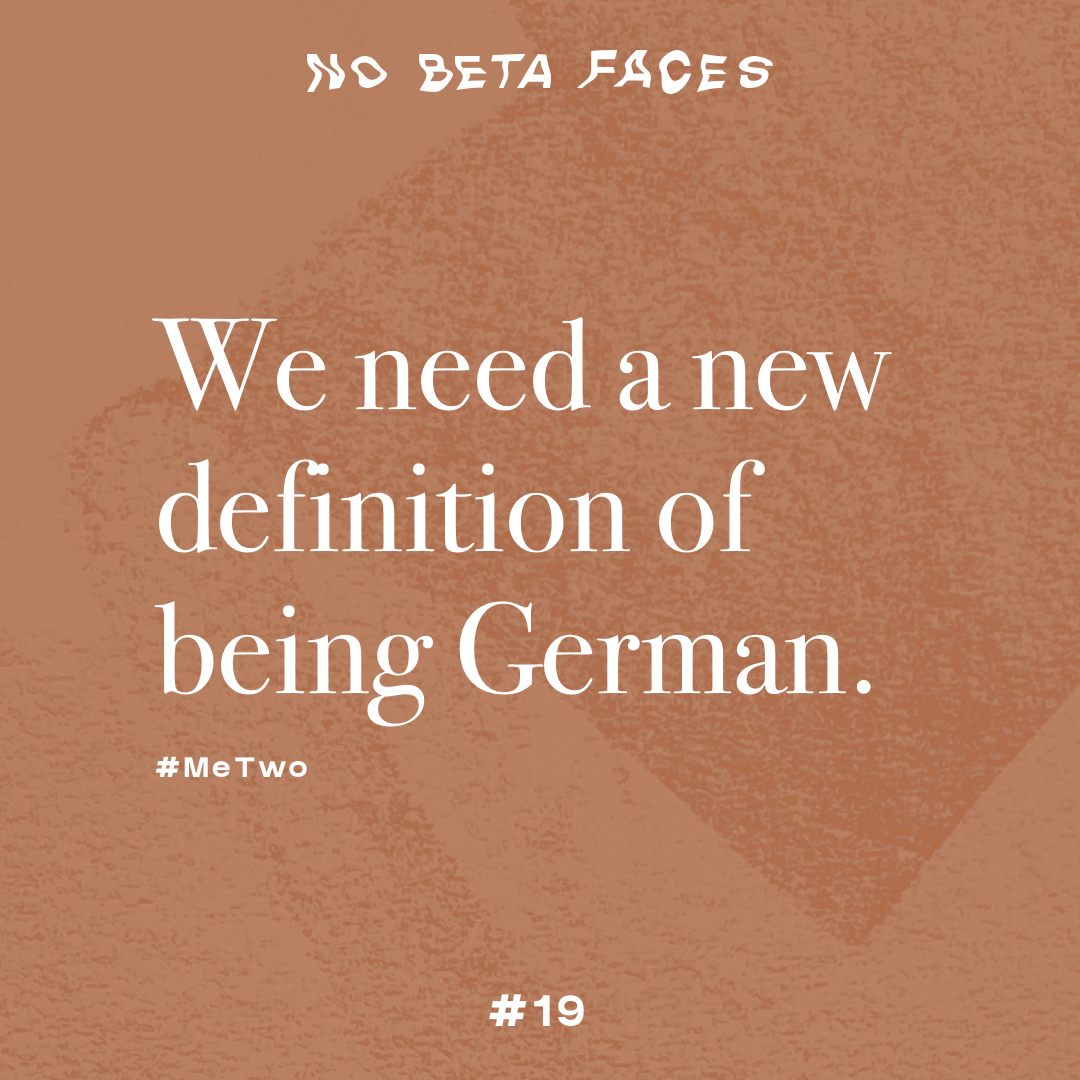
Ali Can brought the hashtag #MeTwo to life. It stands for the fact that humans can have more than one identity. People reported under this hashtag experiences with everyday racism:
- “Goldberg Variations played. Great success. After the concert, I singed a book for a couple, they said: ‘That was so beautiful, even though your spiritual and other origins mean that you cannot have any direct access to Bach and his music.’ #metwo”* — Igor Levit
- “My mother, standing in the corridor during a business trip in a hotel and the woman who comes to her and says ‘you are welcome to do my room now’ #MeTwo” — Mahret Ifeoma Kupka
- “After the first visit to the family of my girlfriend at that time: Her mother to her: ‘For a foreigner he is incredibly polite.’ #MeTwo” — Duhi B.
Ali Can also runs a hotline for “concerned citizens” to help Germans overcome their fear of refugees.
(*All tweets are translated by me.)
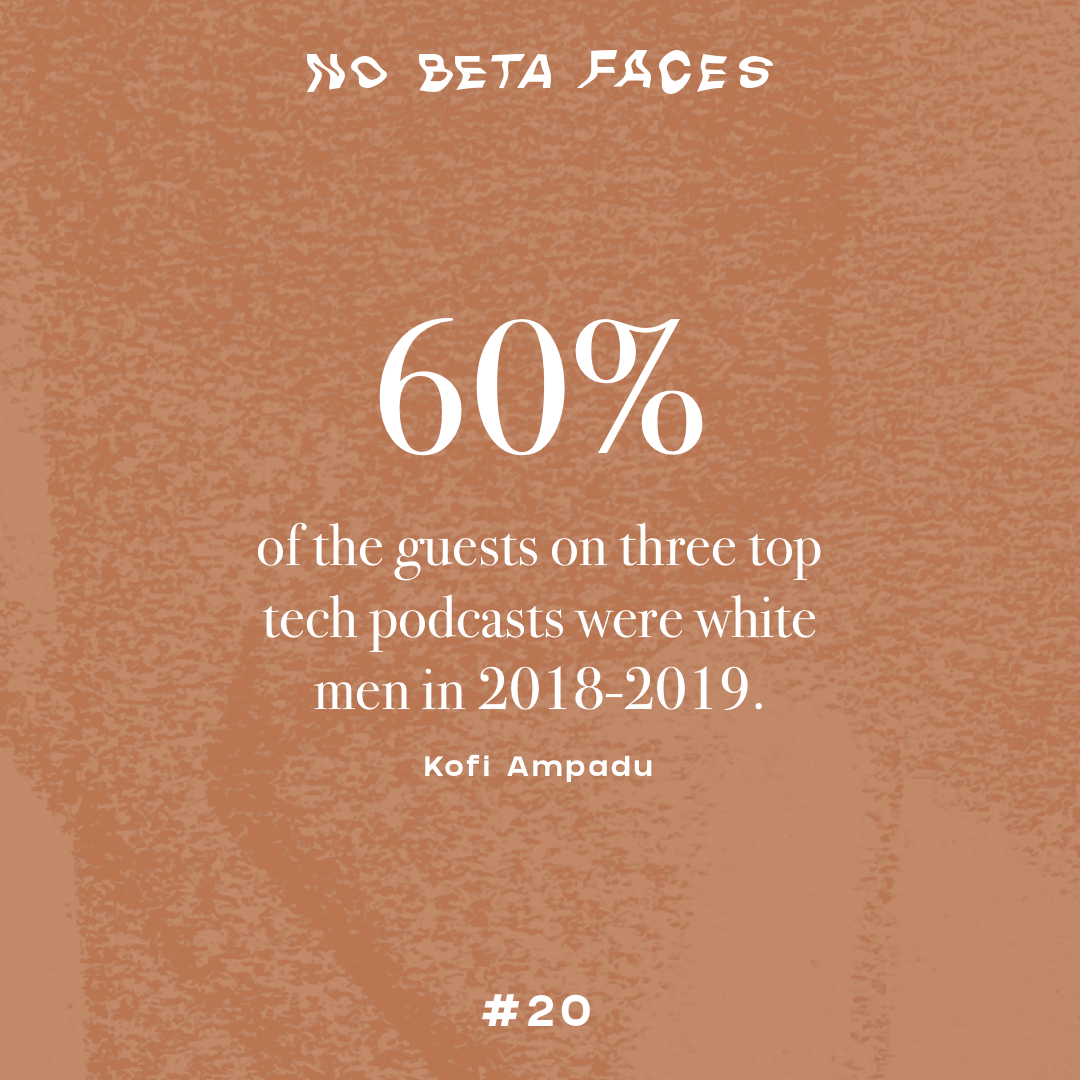
When the same voices are being amplified, a large portion of the population goes unheard. This is true when it comes to the world of tech, and especially in the cases of tech podcasts. In hearing the same perspectives, and those most often from a place of extreme privilege, we begin to live in a bubble that perpetuates the same thoughts and opinions — failing to support alternative experiences or mindsets.
- It’s important we seek out voices different to ours — here’s a good first step: the #POCinSTEM Podcasts article from Designspark.
- To learn more about the lack of Black voices in podcasts, check out this article from Techcrunch.
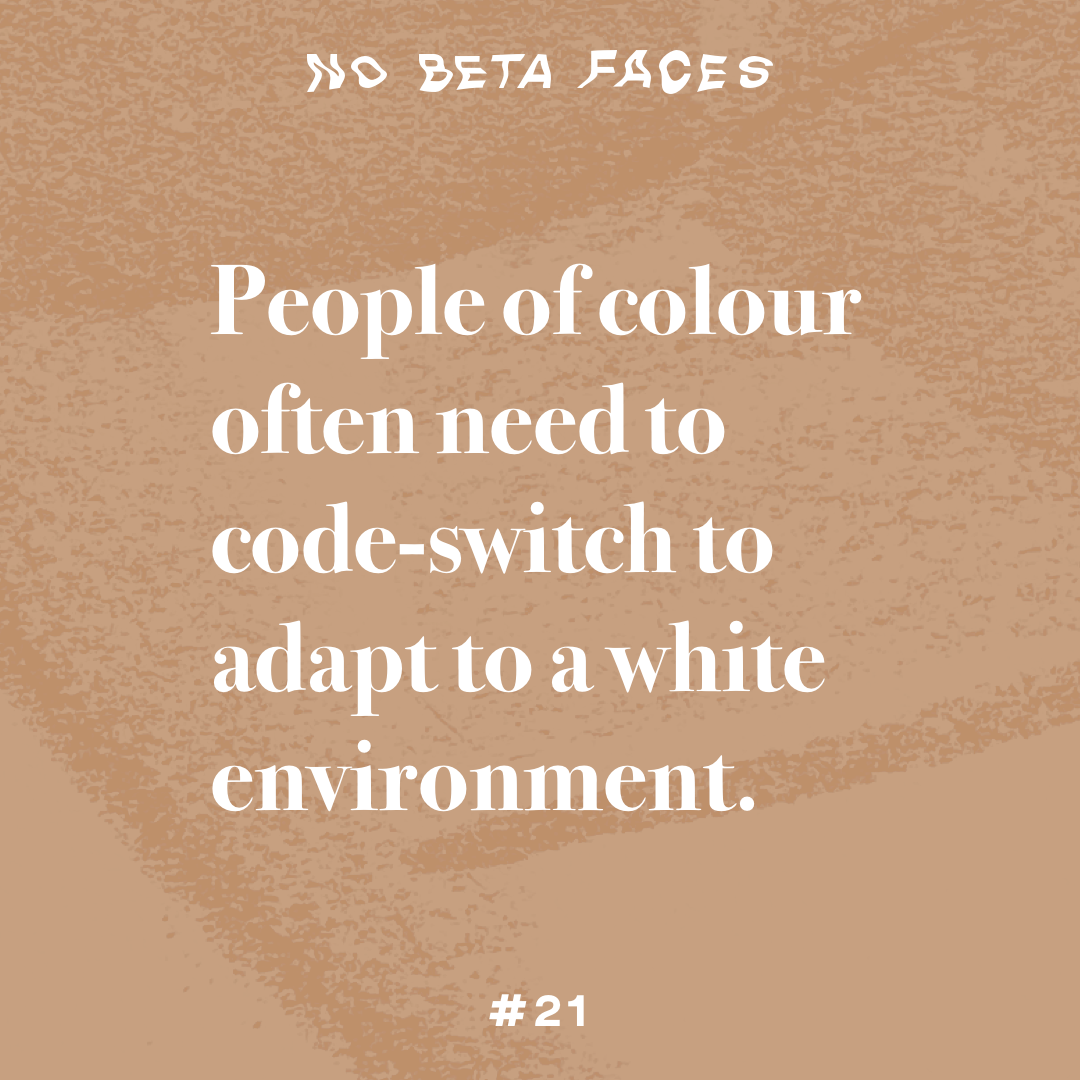
Code-switching is a concept that was first developed in linguistics, as the ability to switch between languages or dialects based on the needs of the situation. The concept was later contextualized in other sciences, such as sociology, and extended to behavioural modifications, as the ability to switch between cultures through the alteration of inflection (in speech), the use of different sets of vocabulary, but also hairstyles, music, clothes, hobbies and more to meet the criteria to be accepted in a situation, location, workplace and other countless settings.
One the one hand, it can be perceived as a special skill to be able to react and adapt to one’s surroundings. But on the other hand, code-switching is utilized in settings in which negative stereotypes “of black people run counter to what are considered “appropriate” behaviors and norms for a specific environment”. In the workplace it might even prevent an employer from getting promoted, e.g. as a Black person in predominantly white work spaces. (Extend this to an intersectional perspective and you see where black women or non-binaries are even more discriminated against.)
The constant need to adapt and deny one’s own heritage also puts enormous additional stress on a person, a burden they have to bear based solely on the colour of their skin. Read more here to dive into an article illuminating “The costs of code-switching” in the Harvard Business Review and understand how valuable representation in the workspace really is.
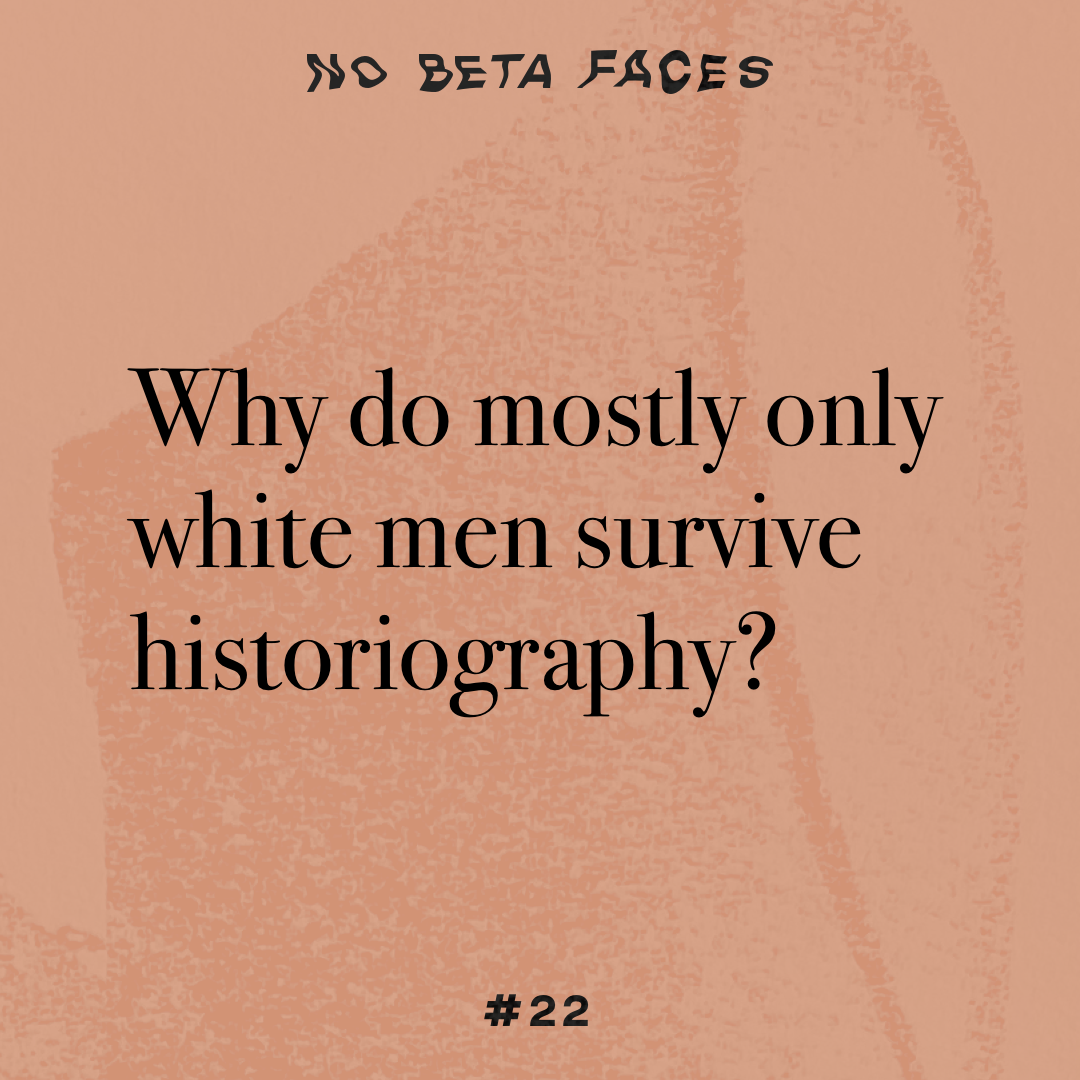
Be it Mozart, Monet or Goethe (who I adore) – in many areas of established art we know mostly only white men. In the past centuries there were also other people practicing than white man – but they have not gone down in historiography. Who or what decides what defines our taste and what kind of art will survive the centuries?
Some projects try to rediscover already forgotten artists from past centuries. Some examples:
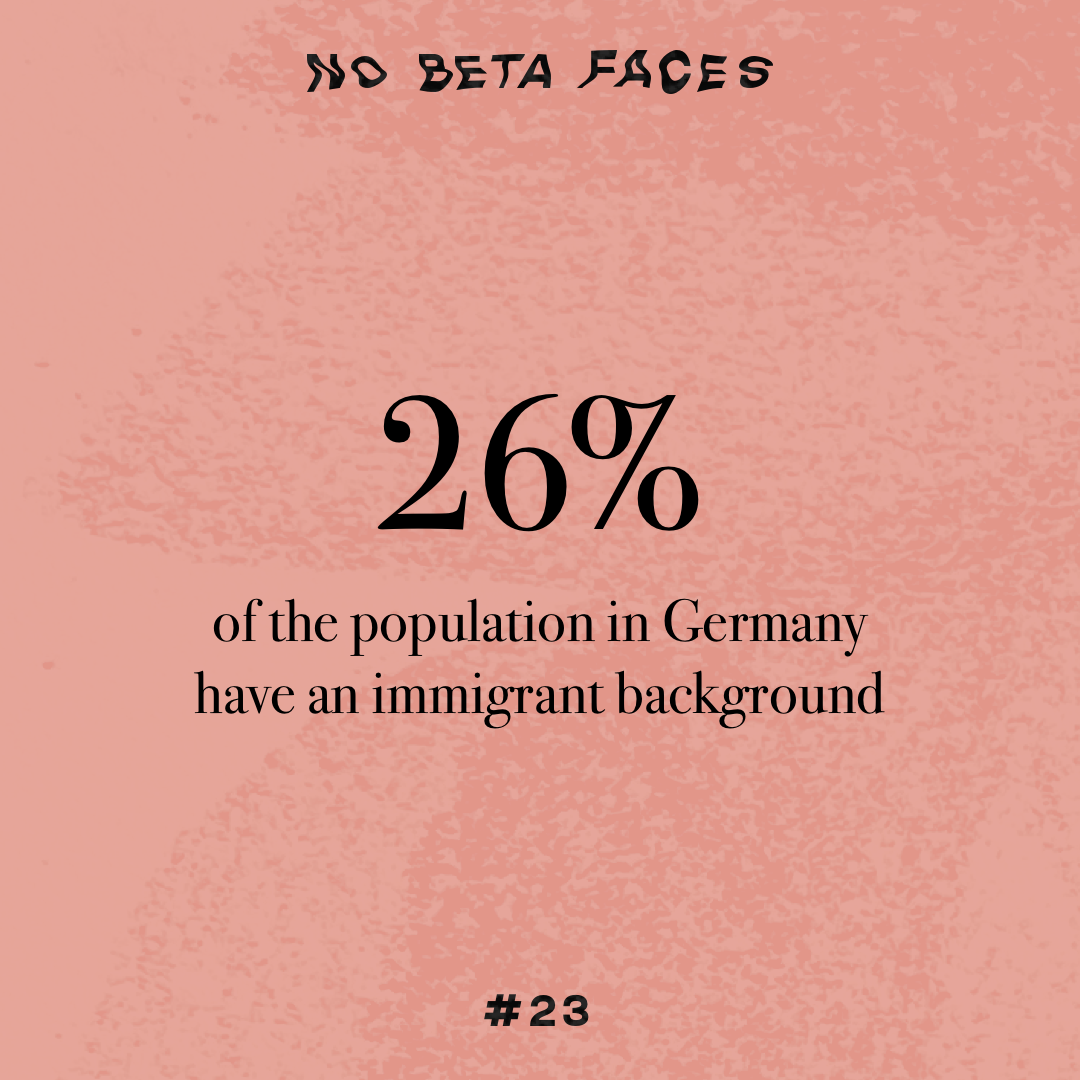
26% of the population in Germany are either immigrants themselves or children of at least one parent not born with German citizenship. This means every 4th person. Do you think this is reflected in our work environment?

A major factor in Germany’s lack of diversity across its companies’ boards is the lack of data on the country’s racial demographics. This creates a problem for identifying underrepresentation in corporate Germany.
“The discussion is on another level [in the U.K.] because we have data on BAME [black, Asian, and minority ethnic] employees there, and you can combine those data with other diversity dimensions, for example, gender,” says diversity and inclusion consultant Floria Moghimi. “It becomes really obvious that women of color definitely find it harder to get the same salary or leadership positions as their white counterparts. It’s visible because there’s data.”
This proves that data is crucial not only for representation, but for showing where change is needed. Read the whole article here which also covers how Citizens for Europe and several other organizations—with the support of Germany’s Federal Antidiscrimination Agency—are working to close this data gap.
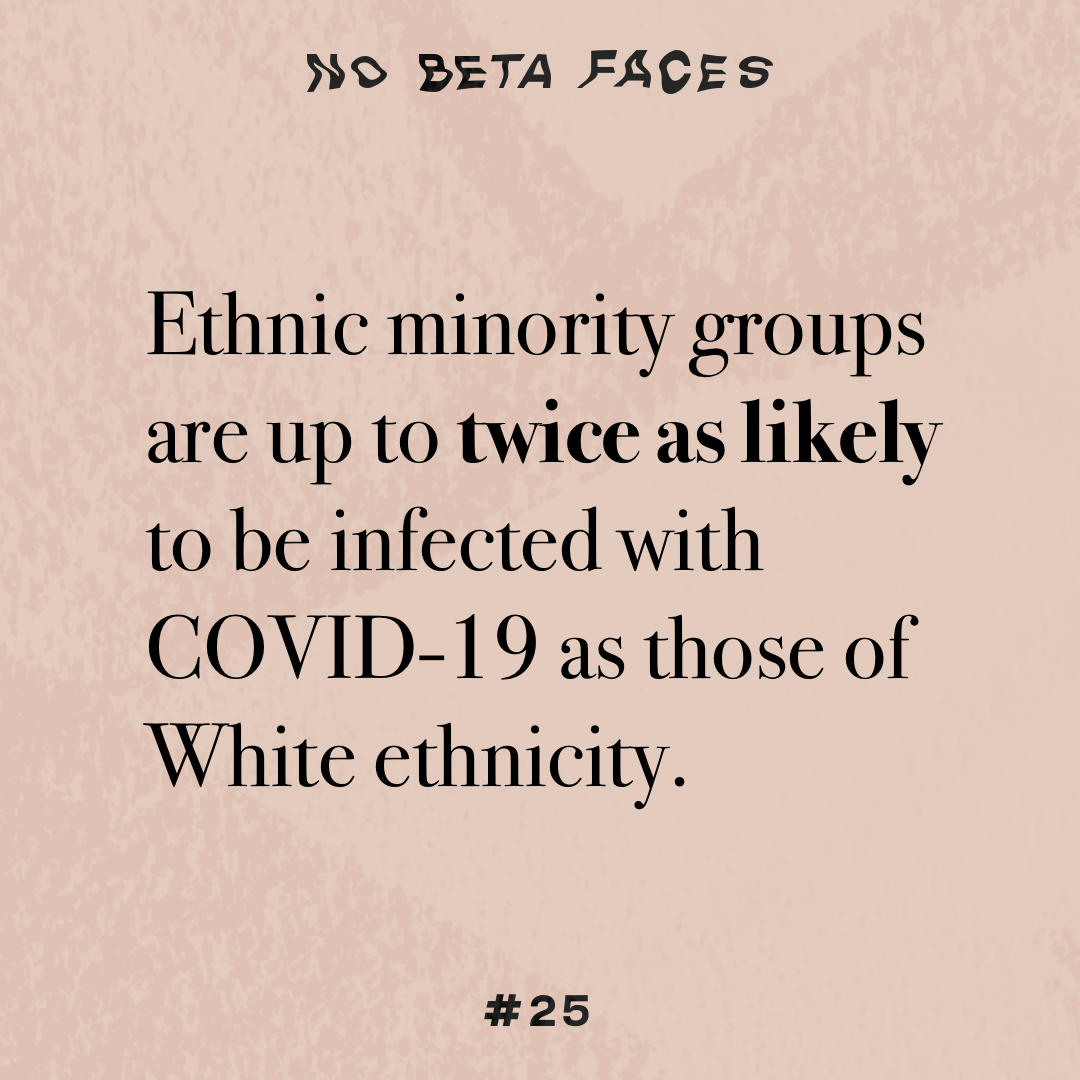
From socioeconomic disadvantages and housing to healthcare discrimination and higher-exposure from working in service industries, minority groups are more likely to be disproportionately affected by and/or infected with Covid-19. What’s more, chronic stress and fatigue from discrimination and oppression further put minority groups at risk. This highlights how racial privilege affects every aspect of life — it’s important we not only be mindful of health equity, but actively work toward achieving it. In our work, but also in our daily lives, it’s important to call to mind these hard truths, as it’s the first step in change.
According to the CDC, change must start with everyone working together: “Community- and faith-based organizations, employers, healthcare systems and providers, public health agencies, policy makers, and others all have a part in helping to promote fair access to health. To prevent the spread of COVID-19, we must work together to ensure that people have resources to maintain and manage their physical and mental health, including easy access to information, affordable testing, and medical and mental health care. We need programs and practices that fit the communities where racial and minority groups live, learn, work, play, and worship.”
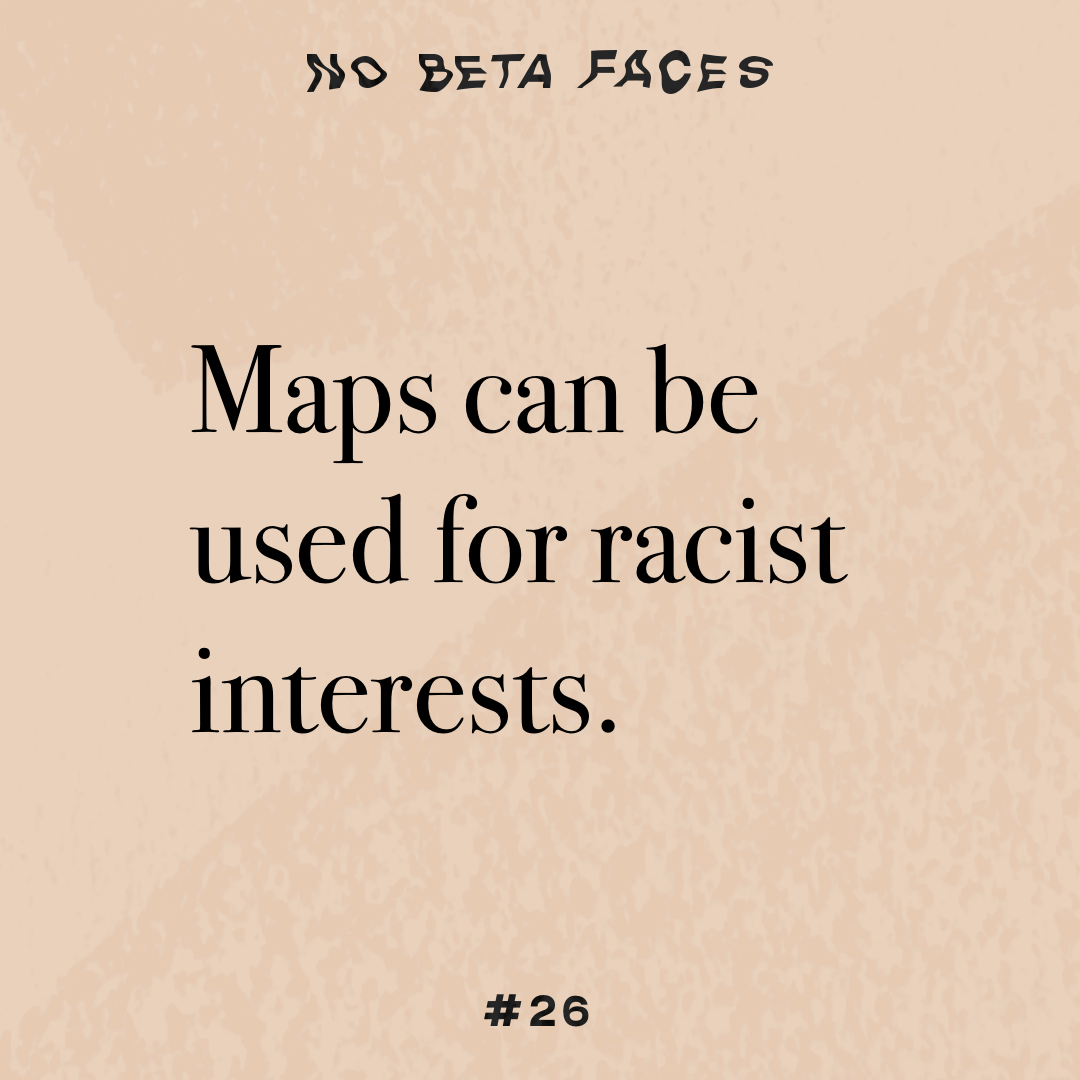
The earth is a sphere. It is impossible to show a sphere on a flat surface. All the maps we know are only an approximation to reality. That’s why there are a bunch of map projections existing today.
A famous map projection is the Mercator projection. It was especially suitable for sailors in the 16th century, because it is accurate in the representation of angles. But its weakness is the visualization of size ratios. Europe and North-America appear larger than they are and Africa looks really small. However the Peters projection is true in its size ratios. But it’s not true in the shape of continents. The Mollweide projection represents a compromise between surface and angular accuracy.
Since we are no longer sailors and have invented better projections, there is actually no reason to stick to the Mercator Projection, in which Africa is represented in a wrong size ratio.

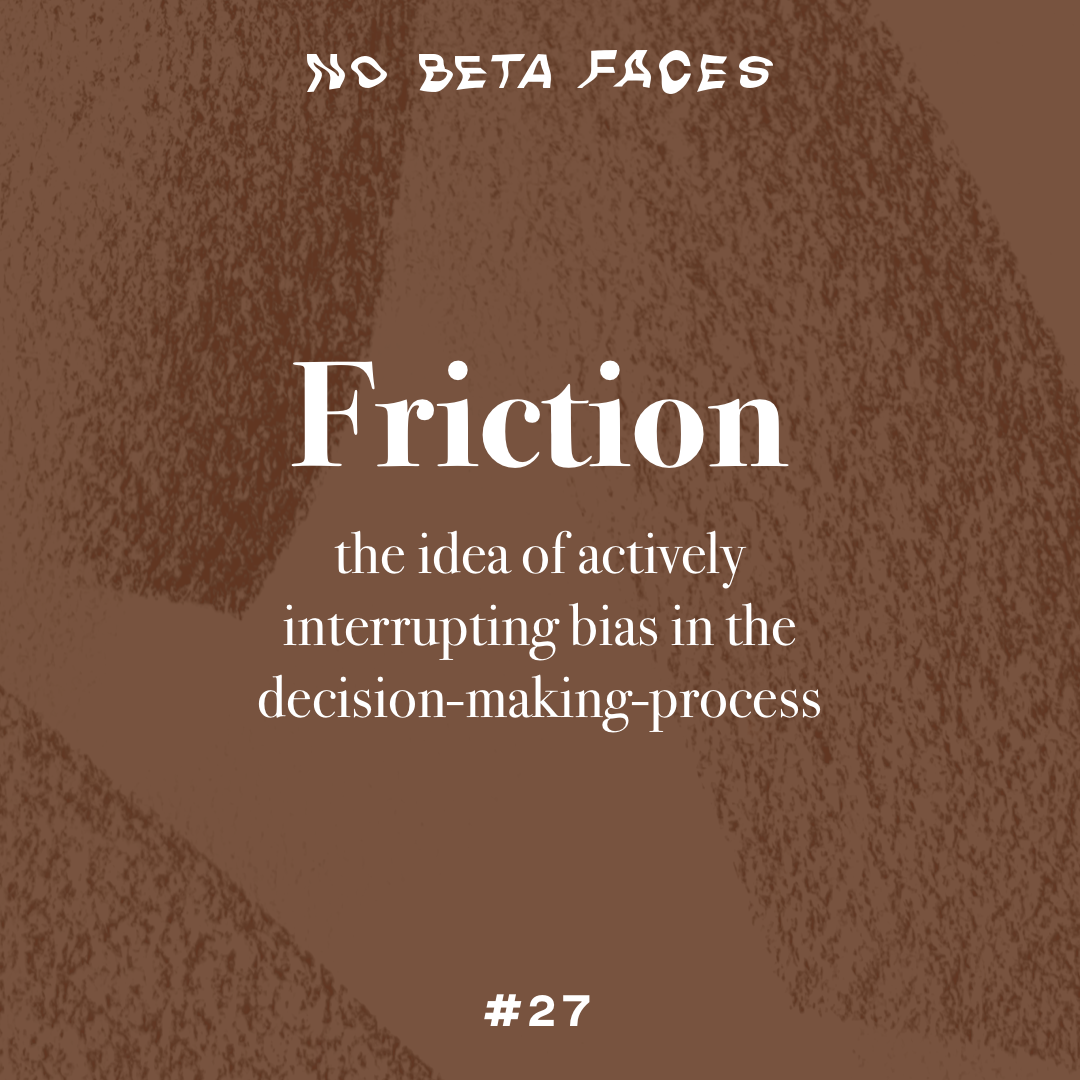
Psychologist Jennifer L. Eberhardt explores unconscious bias and its consequences for society.
What’s that? In her TED talk she explains how our brains create categories to make sense of the world, recognize patterns and make quick decisions. But this ability to categorize also exacts a heavy toll in the form of unconscious bias. So in order to interrupt quick decisions based on bias, she suggests slowing down the decision-making process. This is what she terms "creating friction".
Execution in digital design: A successful implementation of this principle was done in cooperation with the neighborhood community platform nextdoor. The platform noticed a massive problem with racial profiling when it came to posting safety concerns in neighborhoods. By defining a high bar for racial profiling and asking users to specify their reportings, they managed to reduce posts containing racial profiling by 75 %.
![“When you are an F.O.D. [dirst only different] you are saddled with that extra burden of extra responsibility – whether you want it or not.” Shonda Rhimes “When you are an F.O.D. [dirst only different] you are saddled with that extra burden of extra responsibility – whether you want it or not.” Shonda Rhimes](media/posts/no_beta_faces_28.png)
Shonda Rhimes, a female black showrunner of some of the most successful and long-running shows in the US in the past fifteen years like Grey's Anatomy and Scandal, reflects on her own role and burden she had to bear because of her ethnicity and gender in her book “Year of Yes”.
“I was doing a thing that the suits had said could not be done on TV. And America was proving them wrong by watching. We were literally changing the face of television. I was not about to make a mistake now. You don't get second chances. Not when you're an F.O.D [First Only Different]. Second chances are for future generations. That is what you are building when you are an F.O.D. Second chances. As Papa Pope told his daughter Olivia: “You have to be twice as good to get half as much … ”I didn't want half. I wanted it all. And so I worked four times as hard.”
We all have popular examples in mind, when thinking about those trailblazers, F.O.D.s. Barack Obama becoming the first black president only 12 years ago, Shonda Rhimes, a female black showrunner in a male-dominated world of suits fifteen years ago, Kamala Harris being the first female black Vice President in the US … having to represent not only their personal success, but being scrutinized for representing a big chunk of a population and thusly held to a higher standard to open the doors for those who might come after them.

You might’ve made a similar statement, coming from a place of wanting to state how for you everybody is equal and you don’t act based on someone’s skin colour.
But what it really does is negating the real-life experiences and unequal treatment of people with different skin colours. Colour ignorance seeks to erase racism by not acknowledging systemic inequalities – by way of living in Happyland (see post #10).
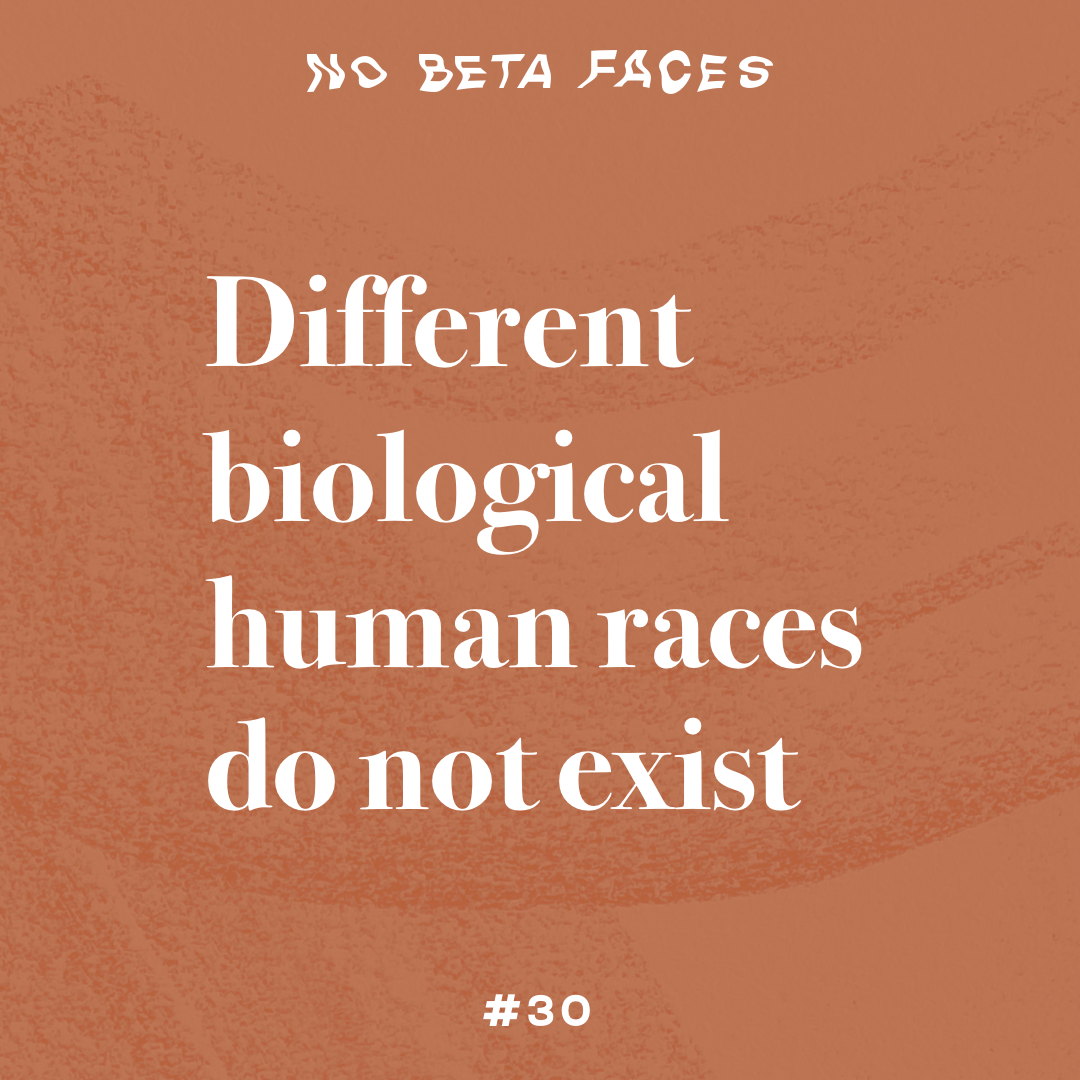
Scientists of the “Jenaer Erklärung” (2019) call to stop using the term “race”. There is no biological justification for a division into human races. The concept of race is the result of racism and not its precondition. Nevertheless this term is still used in the german constitution (hopefully it will change in the future).
“With the concept of race one has tried to separate African people from European people. It has been tried to prove scientifically that there is a big difference between these humans, so that the white people do not enslave their own kind but animal-like creatures.” Sami Omar

According to Ibrahim X. Kendi, the idea of races and hence the attribution of qualities to races can be traced back to the Portuguese royal chronicler Gomes Zurara in the 15th century.
The Portuguese Prince Henry was then creating Europe’s first transatlantic slave-trading policies. As biographer of the prince, Gomes de Zurara created racial difference to convince the world that Prince Henry (and thus Portugal) did not slave-trade for money, only to save souls.
“Gomes de Zurara grouped all those peoples from Africa into a single race for that very reason: to create hierarchy, the first racist idea. Race making is an essential ingredient in the making of racist ideas, the crust that holds the pie. Once a race has been created, it must be filled in—and Zurara filled it with negative qualities that would justify Prince Henry’s evangelical mission to the world.”
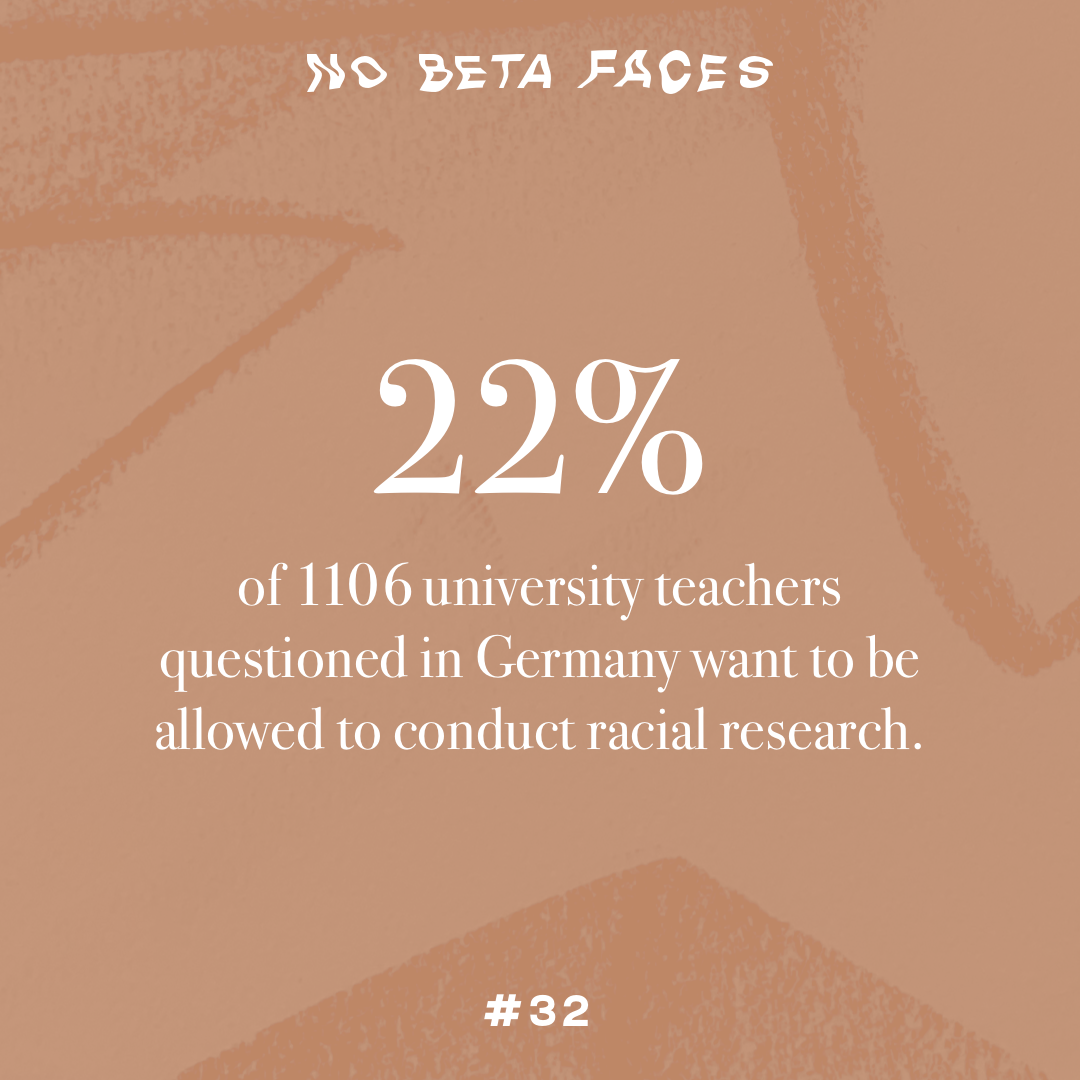
Although there are no different biological human races existing, university teachers in Germany are still interested in race research.
The survey (see page 15) unfortunately does not give any further answers to this tragic statistic and its further meaning.

Until today Germany has not recognized the genocide of the Nama and Herero. After the genocide more than 1000 human remains of the Nama and Herero arrived in Germany. Some of them are still located in german archives, magazines and clinics. The “Stiftung Preussischer Kulturbesitz” has announced that skulls and bones from former German colonies will be returned if it turns out that they were unlawfully brought to Germany. Unfortunately, it will be very difficult to prove exactly where the remains came from, as many documents were lost during the world wars or during archive relocations.
- A podcast about a private person who tries to return an african skull (ARD Audiothek / german)
- An article on dealing with colonial skeleton collections (Deutschlandfunk Kultur / german)

The rights for the opera “Porgy and Bess” are held by the heirs of the composer George Gershwin. According to Gershwin’s wish they determine that the work may only be performed by black people. There have also been attempts to avoid the regulation: In 2019 in Budapest the roles were cast by white singers who then made a written declaration that they felt African-American (→ Süddeutsche Zeitung / german).
In Germany it is almost impossible to perform this opera. The ensembles of german opera houses rarely contain black singers. Only with great effort enough black singers can be found to perform this piece. The other side is, if a black singer in Germany performs a classical song, it is usually the song “Summertime” from the opera “Porgy and Bess”. It was a sensation as three black singers were performing in Mozart’s “La Clemenza di Tito” (= not “Porgy and Bess”) at the Salzburger Festspiele 2017, because it was not usual to finally see so many black singers outside of “Porgy and Bess”.
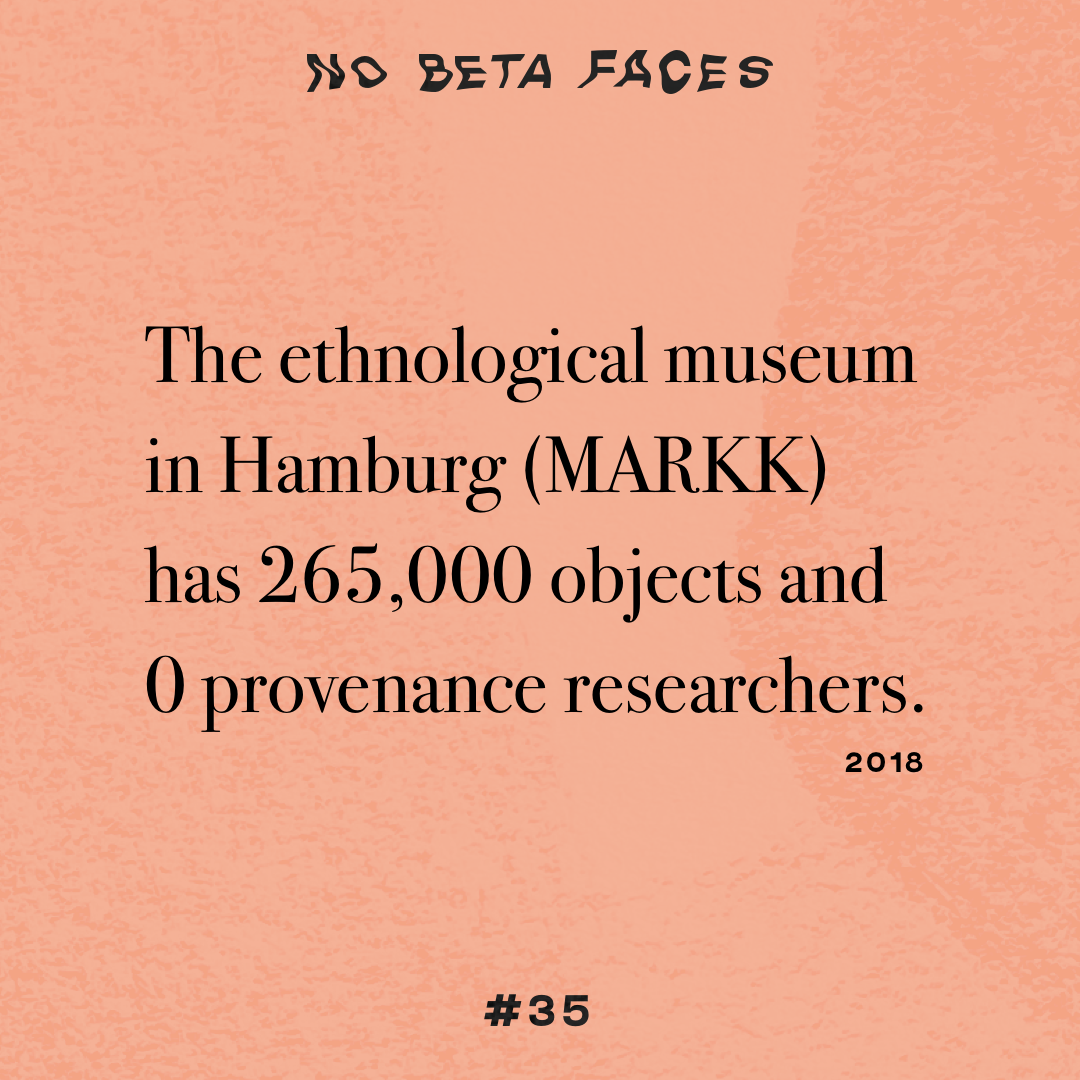
Hamburg is a harbor city. In the past centuries many people have sailed around the globe and brought foreign goods from far away. About 265,000 of them are now stored at the museum MARKK.
Provenance research investigates the origin of cultural assets and seeks information about their former owners. The museum MARKK does not employ a single provincial researcher (at the time of the interview in 2018) – although the “Deutsches Zentrum Kulturgutverluste” provides funding for provincial researchers in a colonial context.
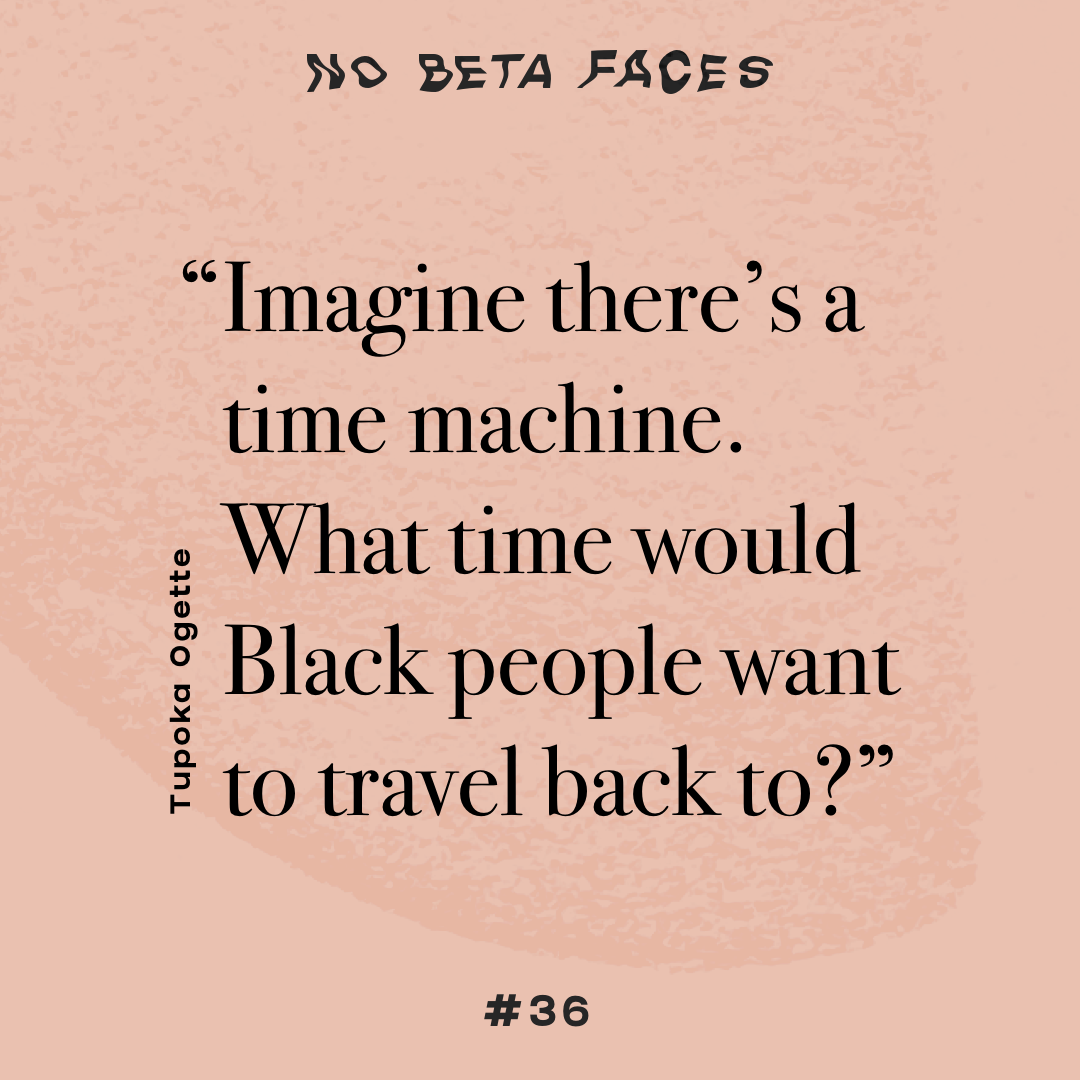
This thought experiment shows that black people have never been privileged.
Visit this interactive timeline about 400 years of slavery and injustice to learn more about the long-lasting systematic suppression of Black people.
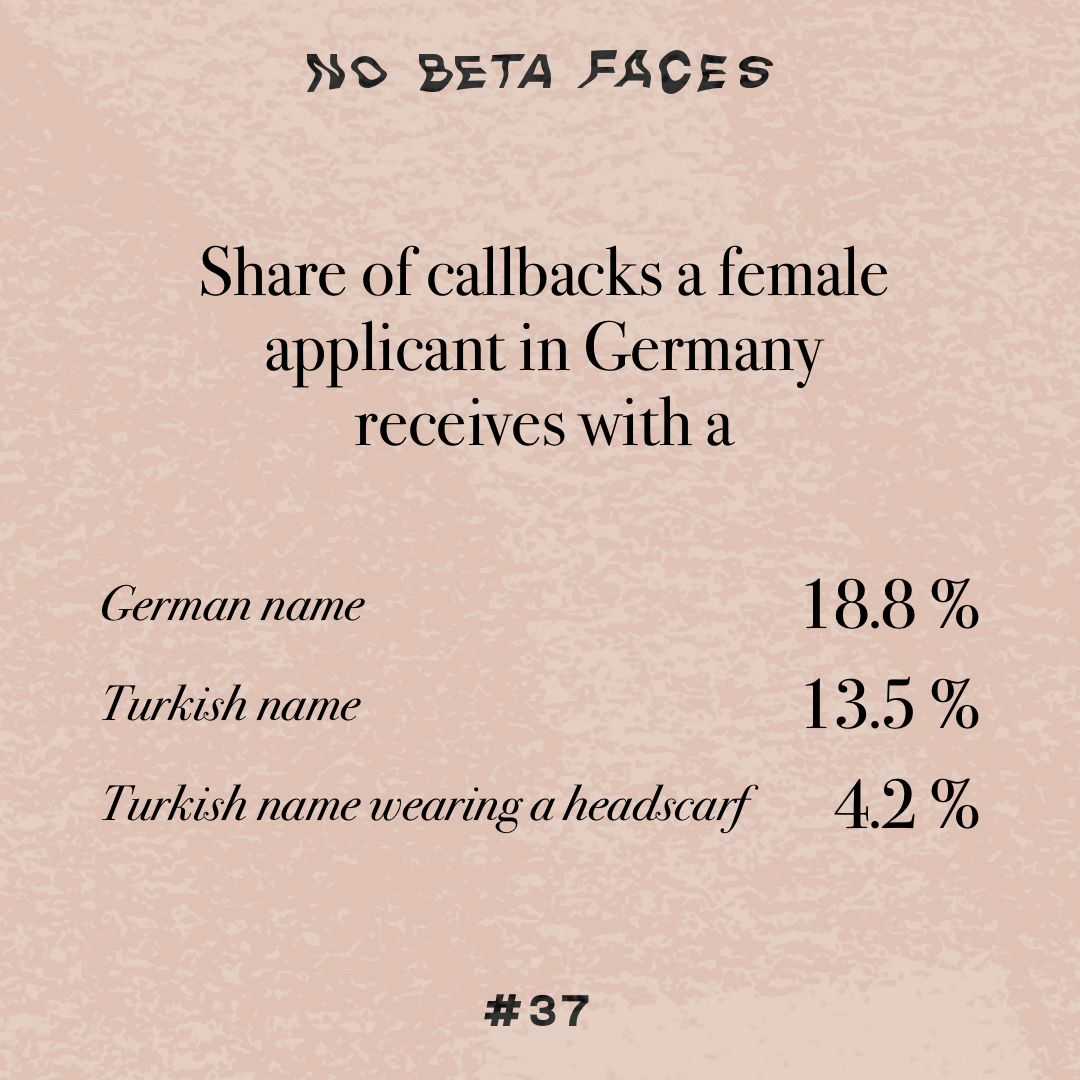
In 2016, Doris Weichselbaumer conducted a study to examine discrimination against female migrants, especially those wearing headscarves. Sending out close to 1,500 applications with only 1 detail changed: a German name, a Turkish name and a Turkish name with the applicant wearing a headscarf.
She discovered that females with a Turkish name wearing a headscarf had to send 4.5 times more applications than females with a German name not wearing a headscarf. In jobs demanding higher qualifactions the multiple increased to 7.6 times.
- Zeit article (german)
- Full study

You will have heard of the Gender Pay Gap (which is the average difference between the remuneration for men and women who are working and is coupled not only to an equal pay, but restricted by social, cultural and legal aspects as well – for 2019 it was a staggering 19% in Germany, with women earning 0,81€ for every 1€ a man makes.
But were you aware that looking at all women across the board doesn’t reflect another dimension: the wage gap for women among racial and ethnic groups is quite different. While the wage gap statistics in Germany focus on Bundesländern and social and educational backgrounds, the U.S. statistics show the next layer, which is likely to be applicable to communities in Germany as well.
Latina women are paid 56 cents to each dollar made by White, non-Hispanic men. Black Women are paid 61.4 cents to the dollar as compared to White men. Asian-American women are paid 89.4 cents to the dollar made by White men. Native american women receive 57 cents to every dollar made by White men.
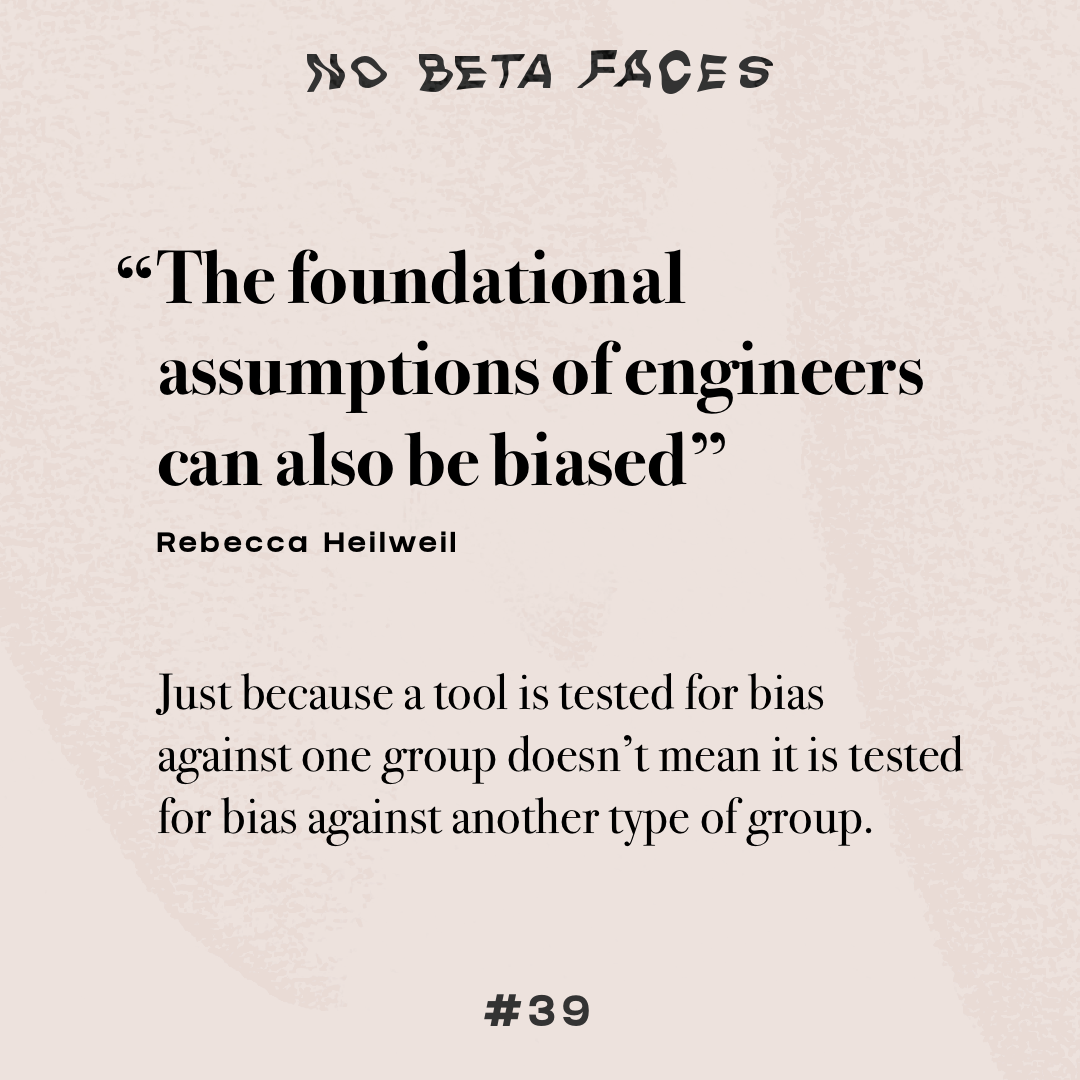
When it comes to alogrithms, it’s important to remember that they’re still man-made, leaving room for racism and sexism. In fact, one study found that, “by teaching an artificial intelligence to crawl through the internet — and just reading what humans have already written — the system would produce prejudices against Black people and women.”
This shows the importance of creating more representative datasets and including more diversity in research. “Turner-Lee emphasizes that we need to think about who gets a seat at the table when these systems are proposed, since those people ultimately shape the discussion about ethical deployments of their technology.”
Read more about this issue here, and let’s be as inclusive and diverse in our daily work as possible. More perspectives mean more insights — chances to make products that speak to everyone.


Though all can post, not all voices are amplified. In fact, social media platforms aim for quantity of quality, allowing for minority posts to disappear in a sea of noise, when they should be preserved. Myspace, for example, a platform many Black musicians relied on, recently lost an abysmal 53 million songs.
“Online, there exists an inherent tension between remembering and forgetting that is particularly tormented, given how little agency we have over how information and memories are stored … With social platforms, there is newly shared culture, and in effect, shared history, but it is one that is vulnerable to a loss as arbitrary as a server migration or company sale. Scholars like Meredith Clark at the University of Virginia and projects like Documenting the Now study how Black people use social media, but those efforts alone are not enough to capture the monumental flow of content.”
“Black Futures” is a project aimed at preserving these important pieces. “He ephemerality of social media terrified us, and as such, inspired us. We also wanted to acknowledge and assemble the multifaceted tiers of dialogues happening among activists, artists, academics, performers and athletes about Black life today.”
Read more about the project here via the New York Times, and remember oppression affects every single aspect of life, including the way we document our lives and the tech platforms we use.

We have discussed how racism is a learned behaviour and how it can be addressed. But educating yourself isn’t a dead end. Educating your children on racism will put them in the position to see and act when they witness unfair and unjust behaviour towards people of colour.
Unicef has put up a list on how to set an example when educating children on racism and developing an anti-racist mindset. It’s little things, that make a huge impact on the next generation to come. Read more here.
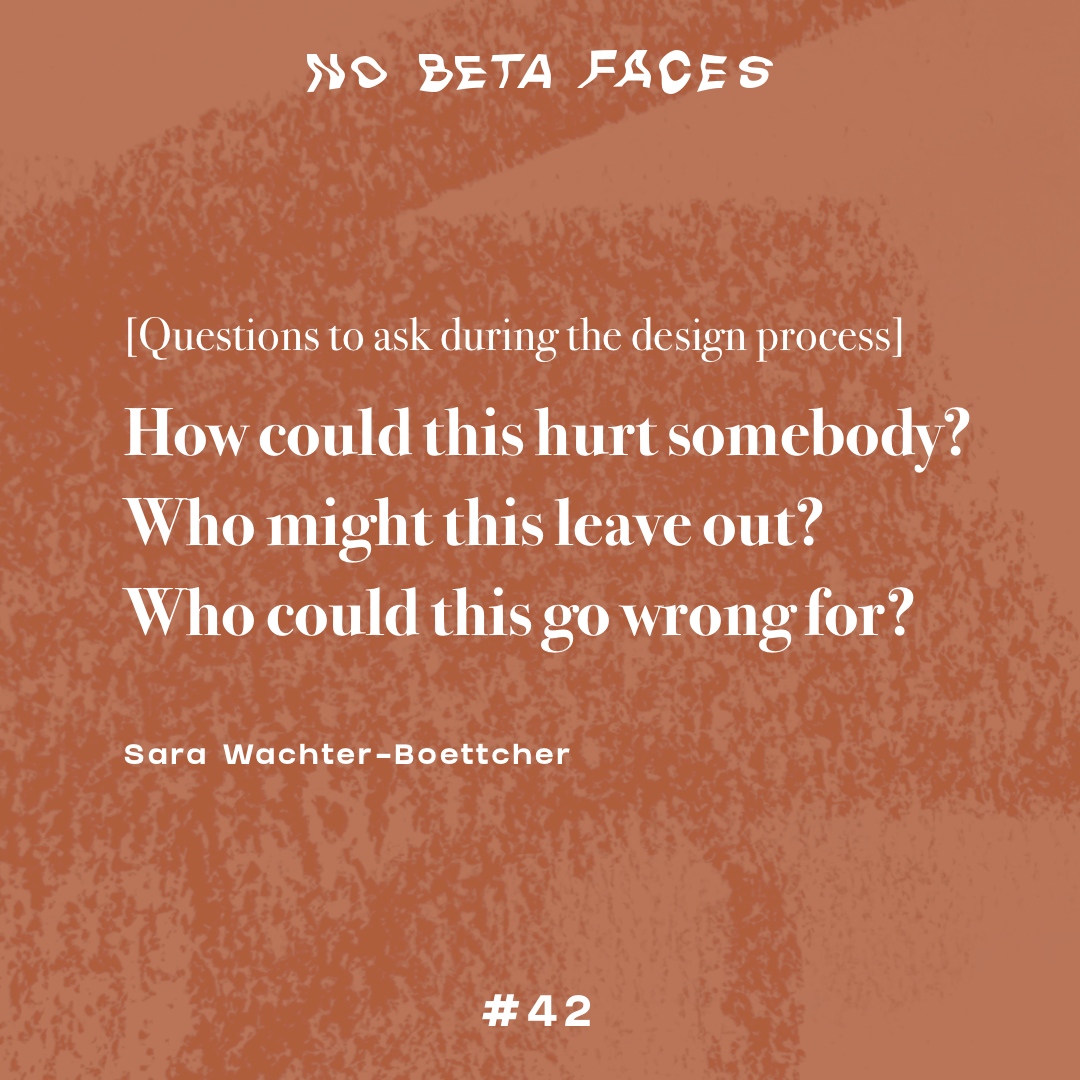
How can we foster inclusive and ethical decision-making in product development? Sara Wachter-Boettcher shares her perspective in her talk “Inclusive Content, Ethical Tech, and You” and discusses the subject in her widely acclaimed book “Technically Wrong”.
“We aren’t talking about mistakes anymore, we are talking about choices” – she reminds us. There are small steps you can already take today like asking important questions when designing. But in order to make your product inclusive, you have to make it a priority and include it in your processes.
Another resource for getting you started on this path is the D4D (design for diversity) framework by Project Inkblot, a team of futurists and designers specializing in Design for Diversity™: How to begin designing for diversity.

In her post “Imagine Your Flexible Office Work Future”, Anne Helen Petersen explores the many ways future work will look, as compiled from her months of research for her upcoming book on the topic. In this, she covers how while remote work does pose challenges, it faciliates a more diverse workforce by allowing workers to work from different cities.
“Is it tougher to collaborate remotely? Sure, but people are smart, and there are so many ways to make remote collaboration actually work, especially when we’ve emerged from our fear and anxiety cocoons. It’s not insurmountable. But trying to work on diversity, equity, and inclusion while insisting that all applicants move to expensive and often exclusionary cities? That is.”
Think Silicon Valley and the income needed to even begin as an intern there. Doing so is impossible without some amount of financial privilege rarely afforded to most. But still, it's where, until recently, most tech companies had workers commute to.
Now, with remote work, people have more opportunities to work for companies which previously eliminated much of its talent pool by its mere location.
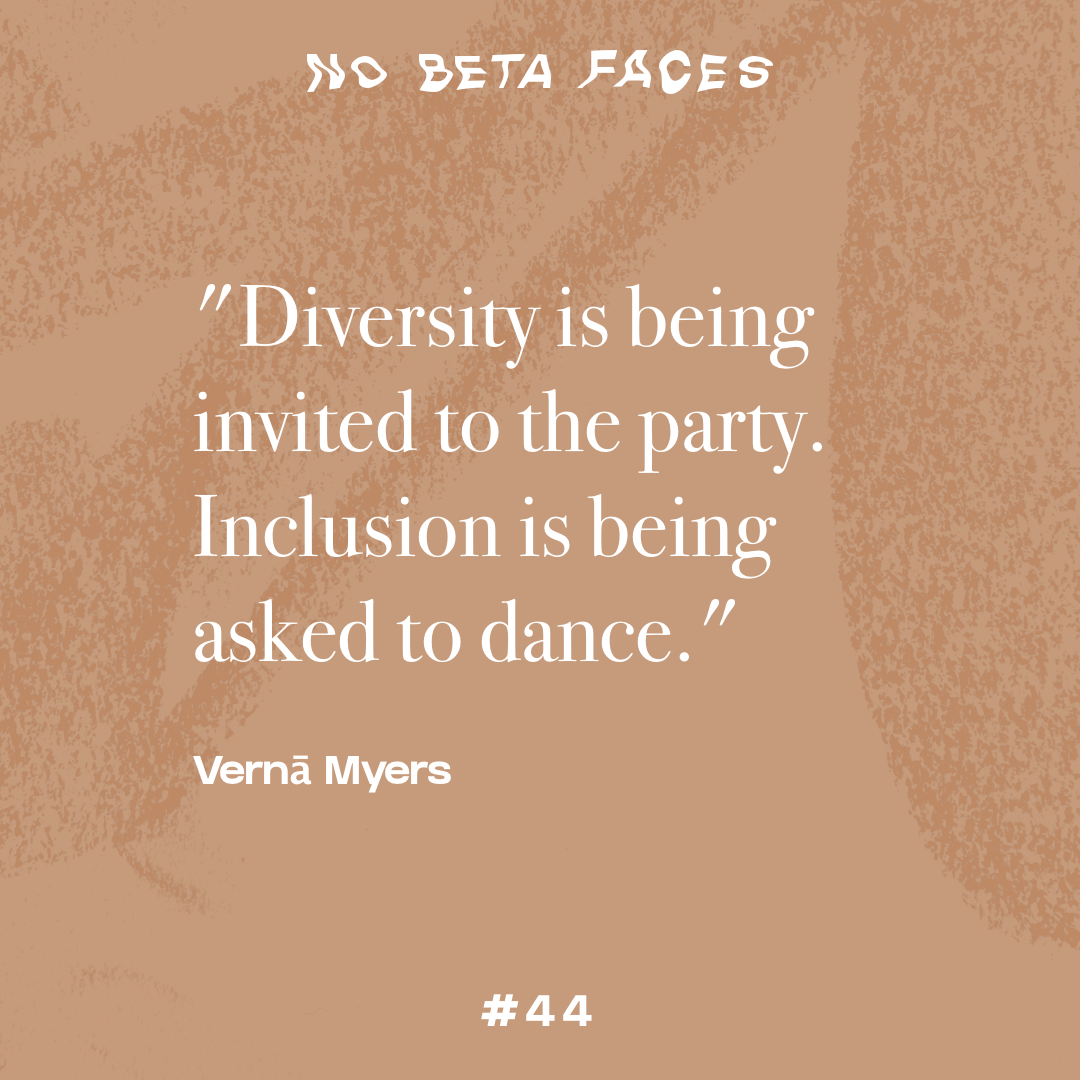
Diversity is a buzzy word that has found its way into society and the work space, like hiring a “diverse set” of employees. But diversity in and of itself doesn’t lead to an anti-racist workplace. Diversity and inclusion consultant Vernā Myers describes the next step as crucial, “being inclusive”. She makes the point that it’s “the institution’s ability to fully integrate its understanding of and appreciation for the diverse cultures and backgrounds of its employees” that is prompting a change.
Laura Sherbin and Ripa Rashid explain this further in their article “Diversity Doesn’t Stick Without Inclusion” in the HBR: “In the context of the workplace, diversity equals representation. Without inclusion, however, the crucial connections that attract diverse talent, encourage their participation, foster innovation, and lead to business growth won’t happen. […] Numerous studies show that diversity alone doesn’t drive inclusion. In fact, without inclusion there’s often a diversity backlash.”
They have worked out four main levers that help to foster inclusion:
(1) Inclusive leaders: Leaders, that possess at least three of the following six traits: “ensuring that team members speak up and are heard; making it safe to propose novel ideas; empowering team members to make decisions; taking advice and implementing feedback; giving actionable feedback; and sharing credit for team success”
(2) Authenticity: Giving room for employees to being their authentic selves (across all dimensions, from their pattern of speech, to clothing and hairstyles, from mannerisms to food)
(3) Networking and visibility: Having a sponsor or mentor that makes the employee visible
(4) Clear career paths: “Formulate plans and programs that offer options and provide signposts that help women, LGBT people, and people of color find the path that’s right for where they are in their lives and careers”

In his book “Cross Cultural Design” Senongo Akpem shares a clear and accessible methodology for designing across cultures: from performing socially conscious research, to building culturally responsive experiences, to developing meaningful internationalization and localization approaches.
“The internet is connecting more people in more places than ever before — and yet many of us still design with only wealthy, Western audiences in mind. As designers and business owners, we know that our audiences extend well beyond single national borders.”
He encourages us to start creating a richer experience for everyone on the web, regardless of location, language, or identity.
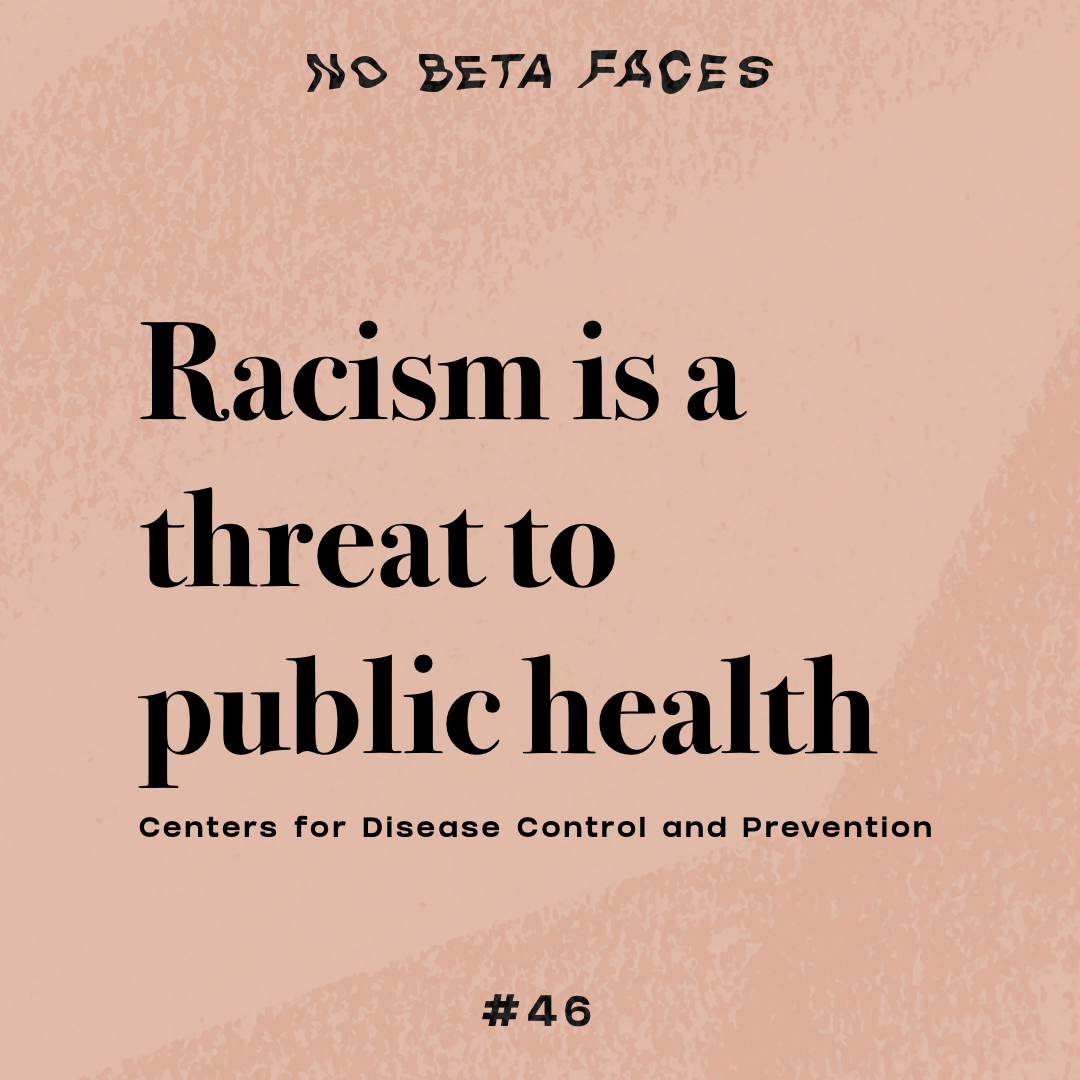
The Centers for Disease Control has declared racism as a threat to public health, acknowledging that structural racism plays an enormous role in public health (see: Flint, Michigan).
“The CDC says it plans to study how social determinants impact people's health - in other words, how access to things like healthy food, good schools, infrastructure, jobs, a healthy environment can all affect our health. This is what people mean when they talk about structural racism. It's really the fact that different racial and ethnic groups have unequal access to these things. The CDC is also now doing things like partnering with churches to help create community vaccination centers. These are for COVID now, but CDC hopes that this will create lasting infrastructure that can be used for, say, cancer screenings or childhood immunizations later down the road.”
While the CDC is America-based, the sentiment rings true across the world. Structural racism exists, and its implications have far-reaching effects that impact the everyday lives of those oppressed.
“In running her agency using a racial equity lens, Dr. Mary Bassett of Harvard, a former New York City health commissioner, was able to detect disturbing discovery when it came to swimming-pool deaths: They found a large difference in risk of a swimming-pool drowning for Black children as compared to white children. And because they had this racial equity lens at top of mind in all their work, it helped them think of creative solutions to address this. In this case, the agency got the parks department to volunteer lifeguards. They started offering free swimming lessons to kids in low-income neighborhoods, which tend to be Black and brown neighborhoods. Bassett says this is the kind of thinking that happens when you address the larger conditions that put people at a health disadvantage.” (Read more at: NPR.)
How can we think broader, bigger, and more inclusive in the solutions we create, to better the lives for all, and help dismantle the systemic racism around us?
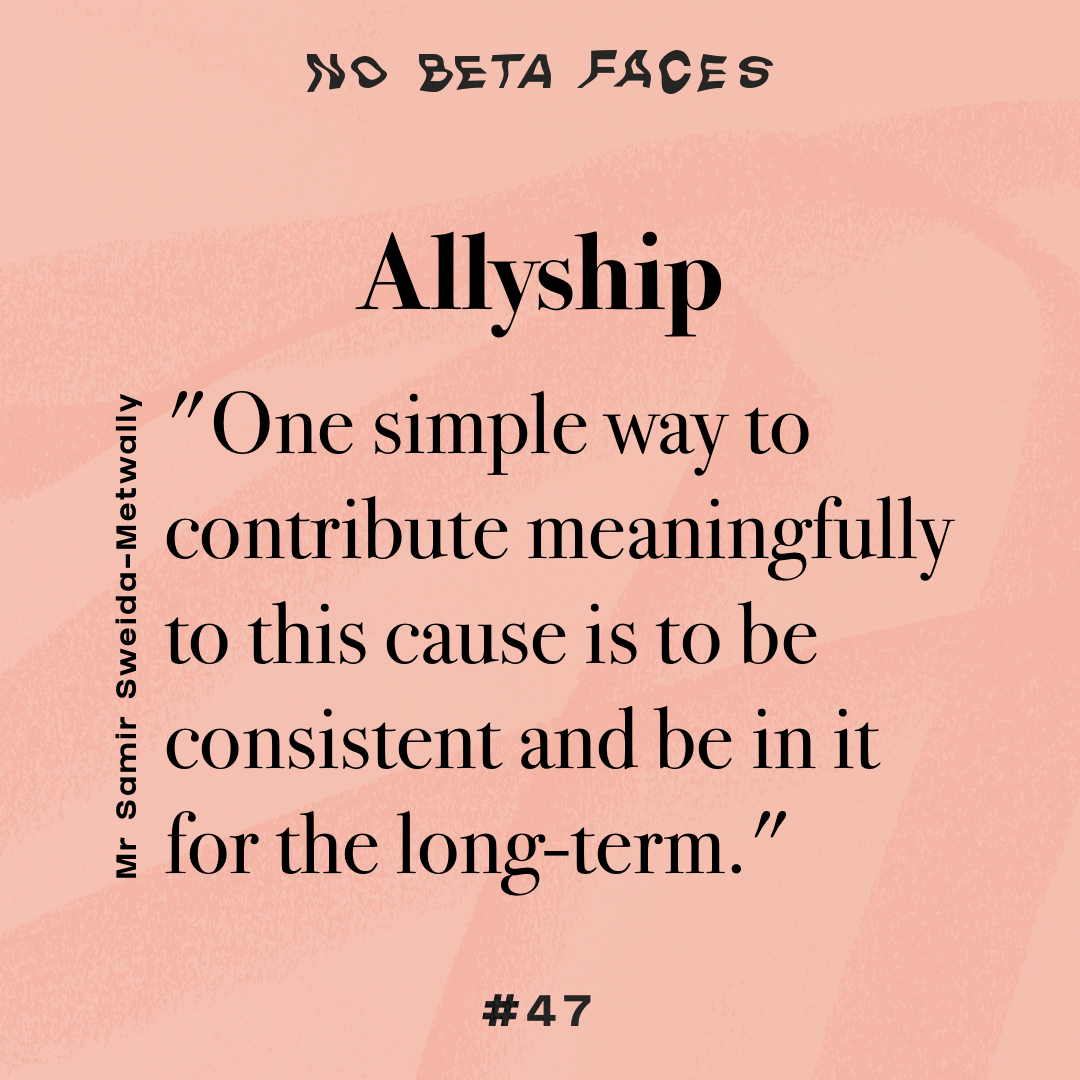
You’ve become aware of what it entails to be an ally. You’ve understood, how racism is institutionalized and runs through the very core of our societal fabric. How do you shift from posting a black square and the hashtag #blacklivesmatter to becoming an ally?
Becoming an ally is a constant state of being, that won’t be easy and/or without backlash. But truly stepping up against racism entails being in it for the long run. Think how you can switch of your laptop or log out of Twitter – what a privilege, that people of colour don’t possess.
A couple of things to bear in mind when implementing an anti-racist mindset:
- it’s continuous, not of the moment
- keep educating yourself and don’t demand to be educated, it’s your task and not the one of oppressed, that carry a whole lot of other burdens already
- call out anyone (friends, family, colleagues, managers, people on the street and the supermarket) especially in situations that may seem unnecessary to you or are uncomfortable
- think how you use language and its politics, refrain from talking about “riots” or “looting”
More on how to be an ally can be found here and here in a reflection by Samir Sweida-Metwally for the European Network against Racism and through the weekly impulses we collected over the past year.
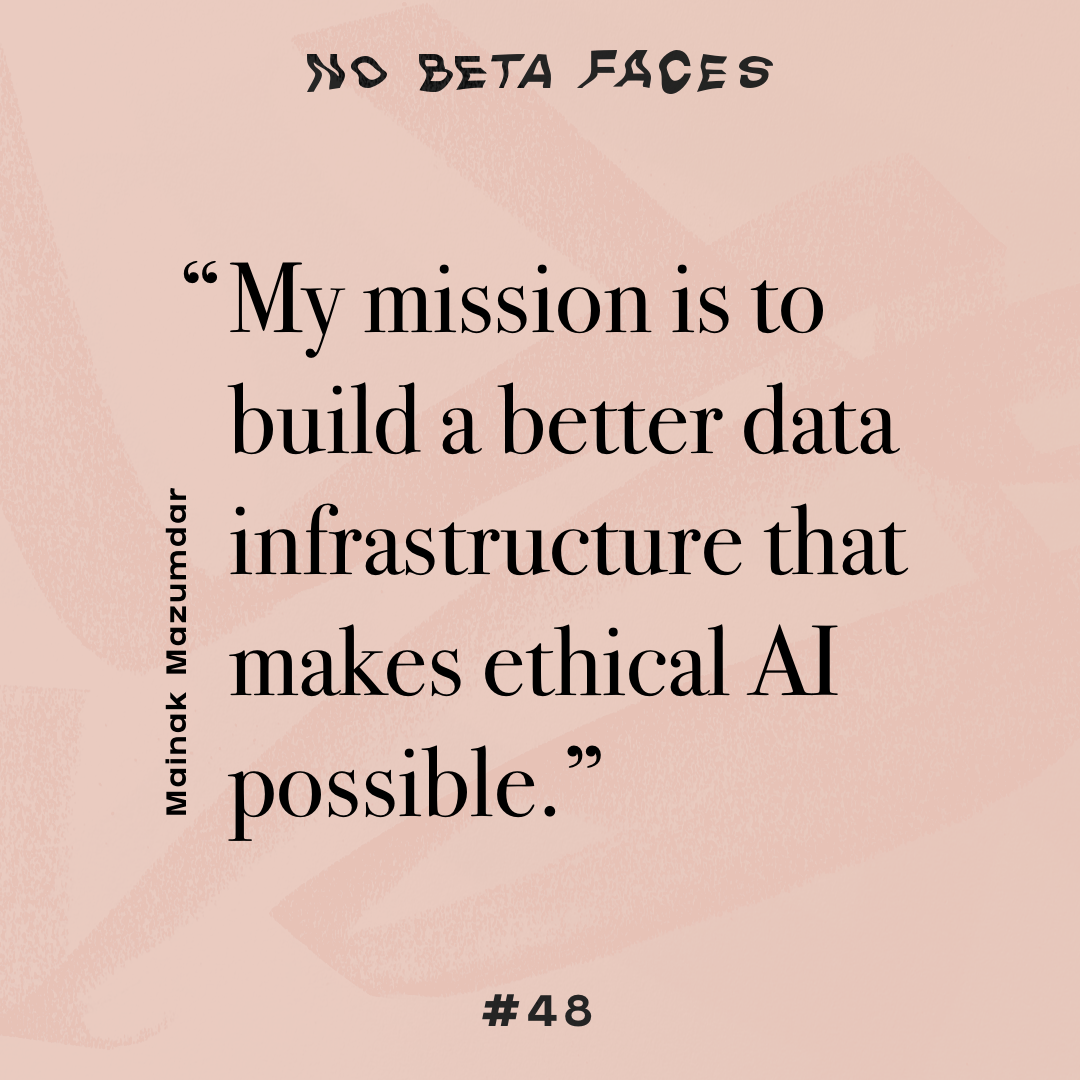
Data scientist Mainak Mazumdar is advocating to rid AI of bias through data quality: “We’re spending time and money to scale AI at the expense of designing and collecting high-quality and contextual data. We need to stop the data, or the biased data that we already have, and focus on three things: data infrastructure, data quality and data literacy.”
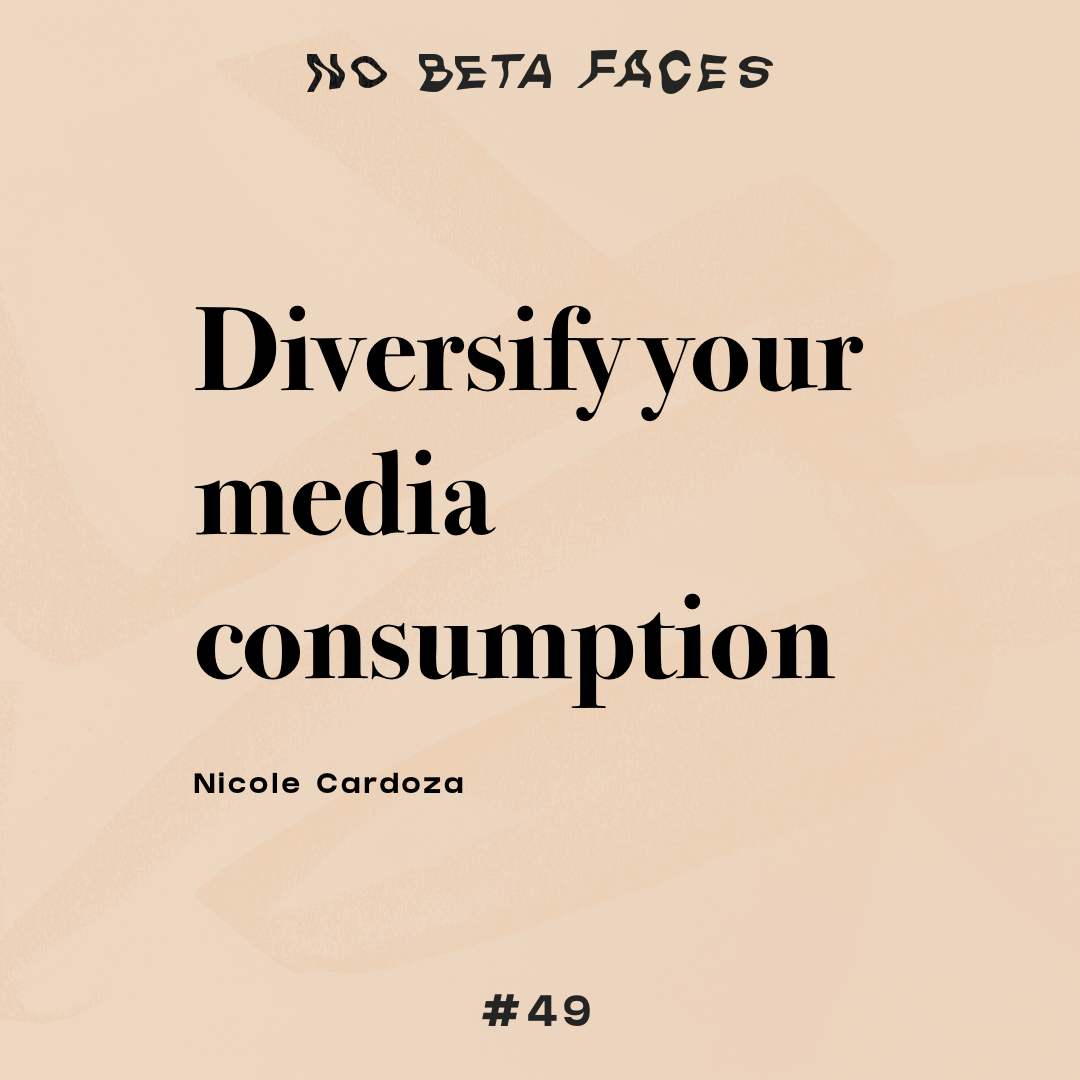
Think of your go-to news sources. How many articles do you read by people of color? By women? Who is on the executive leadership team of this news organization? What stories, if any, have come up in the past two weeks about representation and equity in their workplace? The voices most amplified are the ones that hold the power.
“When it comes to dismantling systemic oppression, representation and equity in media reporting is essential. Historically, the media has done more to uphold racial bias against people of color than dismantle it. Racial bias is a form of implicit bias, or the unconscious attitudes or stereotypes that distort our understanding, actions and decisions. Our racial biases are largely influenced by the media and how it chooses to center and elevate people and conversations.”
We live in a time where we have access to an Library of Alexandria level of information. Make use of this by following more diverse perspectives. Invest in new forms of media, like Google Docs and Substack. Remember that even the most "progressive" of news sources are fall short in terms of representation. (Columbia Journalism Review, Nieman Lab).
Start here. And remember to al.
Diverse media resources (a VERY non-exhaustive list):
- Blavity
- The 19th
- them
- Zora
- Univision
- NYTimes Race Related
- NPR Code Switch
- Women’s Media Center SheSource (which highlights diverse female voices to go to as experts for specific subjects)
- List of black-owned local publications
- Media Bias Fact Check, that analyses implicit bias in news
- 13 Women Of Color In Journalism You Should Know

There’s not a lot to add to this statement. We see it as a mission statement, an appeal and an ongoing reminder to not only inform ourselves on anti-racism, but act on it. Constantly.

This 1-year anti-racism learning journey is coming to an end soon, but of course the issue is not any less relevant or urgent. What we do here at SinnerSchrader in our daily work affects millions of users internationally and I am encouraging you to consider the impact you make at and through your work.
Here are some resources to get you started implementing changes in your work:
- Tupoka Ogette, author of “Exit racism”, is hosting a series of workshops for Accenture employees! Check last week’s MMM (May 31st) to learn more about how to participate. I had the pleasure of joining last week and it was truly eye-opening – a big thank you to the accenture HR I&D team.
- GlobeSmart is a resource provided by Accenture helping you do business across borders:
- To find out how culturally savvy you are, you can take the Accenture diversity quiz
- Janey Lee, Designer at Spotify on uncentering her design practice
- A resource list for getting started uncentering your design practice
- “Consequences of our design” working template by Spotify
- Having an open conversation about anti-racism in your team with Gatheround’s templates
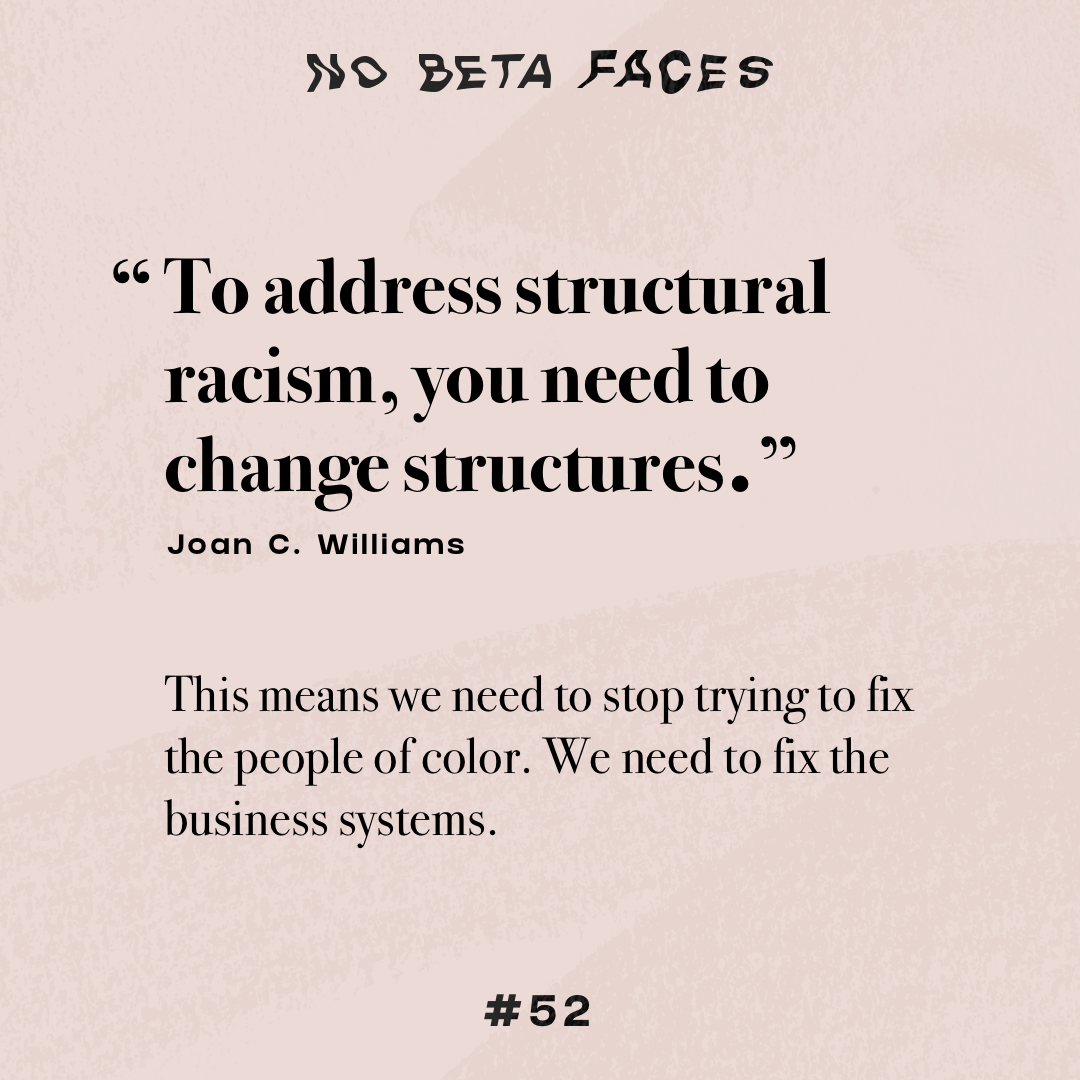
#52 - this is our final post.
We are ending this series about anti-racism on a personal note, sharing what No Beta Faces means to us. Can’t wait to hear from you & thank you for bearing with us for the last 52 weeks!
I want to especially encourage you to tackle racist structures in the work place and in the work that we do. For that, I leave you with this quote by Joan C. Williams: “If a company was facing challenges with sales, it wouldn’t respond by holding a series of sincere conversations about how much we all value sales and put on programming for ‘National Celebrate Sales Month’ and expect sales to improve. But that’s a lot of what we’re doing in the diversity context. If we really want to tackle diversity effectively, we need to use the same tools businesses use to tackle any business problem – evidence and metrics.”
Racism is a system. We white people are all inside it and benefit from it. The “solution“ is not about attending an anti-racism workshop for 2 hours and being “clean” afterwards. We need to recognize the structures every day to attack the dominant paradigm. The racism system has been integrated into our thought structures for a long time and we don’t need to be ashamed of it. Blame the system, not yourself. We need to understand the system, perceive it and take responsibility for it. We need to recognize, when we white people are behaving unfairly. We need to sincerely apologize for bad behavior and then do better. That takes courage, but that’s the least, isn’t it? 25% of Germans have a migration background. When was the last time you made a rash decision about such a person based on their appearance?
As we wrap up this iteration of No Beta Faces, I feel both honored and humbled to have been a part of such an initiative. The research, reckoning, and regrets all forced me to step outside of my bubble of privilege and come face to face with the injustice surrounding us every day because of racism. What’s more, it’s helped me to truly reconsider what it means when we say we are “human-centric” in our work, and how we can ensure that our products and innovations truly represents all voices and perspectives. I couldn’t imagine a better group people than those here at S2 to take on such a immense injustice as racism to help create substantial change in our society. I personally pledge to continue educating myself in regards to the topic and being a better ally; taking actionable steps toward righting inequalities; and forever speaking out against discrimination, inequalities, racism, and for those who are silenced. I leave with you this quote by activist, community leader, and author Grace Lee Boggs as both inspiration and a challenge: “You cannot change any society unless you take responsibility for it, unless you see yourself as belonging to it and responsible for changing it.”
Going on this journey and recognizing structural, systemic racism all through society, not in a far away country, but around us, every day, has been my biggest learning. Being aware of inherent racism all through society, be it from our own use of racist language to racist biases in tech and design, makes me walk through life with opened eyes. How can the colour of skin be the default for something? And where can we make an impact to change the paradigm? Kind of everywhere. From educating ourselves, being sensitized about language and codes, to calling out unfair and racist behaviour to being a constant ally, not only by words, but by actions.